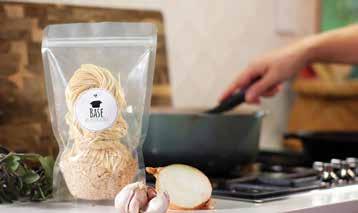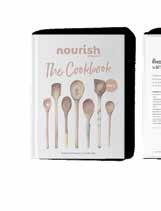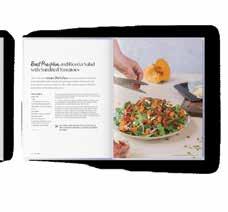





We believe there’s always room for progress, even in a bestselling SUV.
The Audi Q5 already boasted a sporty character with quattro all-wheel drive, now we’ve enhanced it with 20-inch diamond-turned wheels and carbon mirror detailing. The interior that brought premium to everyday life, we’ve taken it to another level with a limited edition trim, USB charging in the rear, and heated, power-adjustable front seats. But what really cements this Q5 as a showstopper, is the price.
The Audi Q5 limited edition, available from $92,990 while stocks last. Register your interest today. Looking this good, they won’t last long.
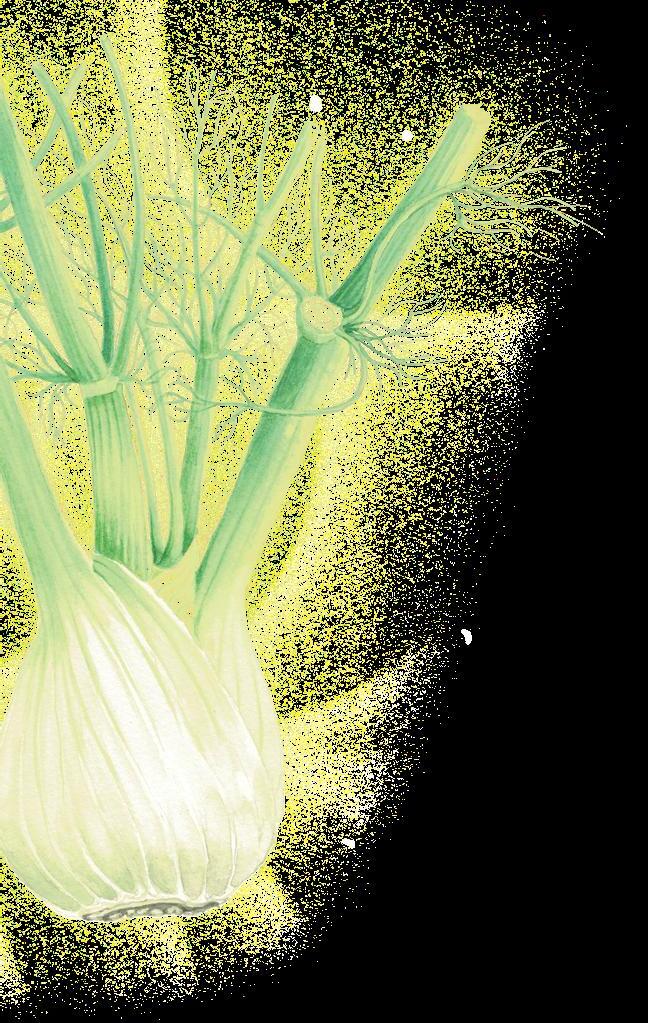
Galloway, Amber Bremner, Kathy Paterson, Fiona Hugues, Vicki Ravlich-Horan. ISSN 2324-4356 (Print) | ISSN 2324-4364 (Online)
ADVERTISING
Vicki Ravlich-Horan vicki@nourishmagazine.co.nz 0210651537



Spring is here and if you are looking for a proven performer, contact me for a confidential appraisal and marketing recommendation designed to achieve the best results.
Our powerful regional network, backed by national and global reach, coupled with innovative marketing and local expertise, means you get the best service and results.
Trust me to deliver the best possible outcomes for all your property needs.

BAYLEYS REAL ESTATE AGENT




Robin Williams said, “Spring is nature’s way of saying, let’s party!” So who are we to argue? Spring happens to be our birthday season and this year we celebrate 14 years of bringing a fresh slice of flavour to the Waikato.
Celebrations always call for cake, so on page 8 I share my Chocolate Celebration Cake from our latest cookbook. Like so many of the recipes in this book, it is a tried and tested recipe that gets pulled out often, as it is so easy but so delicious.
Also celebrating a birthday is Vetro Hamilton. Read about this and their planned spring festival on page 10. Continuing with the milestones, Made in Hamilton East will mark one year at the end of spring, so Denise Irvine went and had a chat with a few of the tenants and customers loving this new development in Hamilton. Read about it on page 12.
If you are planning some celebrations at yours this season, head to page 70 for Harriet’s ultimate guacamole recipe, perfect whatever the occasion!
Spring means asparagus and strawberry season are here. On page 21 Kathy Paterson shares her famous asparagus rolls, just the ticket if feeding a crowd. And on page 18 Amber Bremner hails in strawberry season with some ripe recipes.
As the days get longer and warmer there really isn’t any excuse to get out there and experience more of our region. On page 27 we did just that with Ebbett Audi, enjoying a wonderful day in the Waikato.
In this edition we launch what we hope will be a regular feature, Nourish Learn, with some of the great workshops on that you can partake in and learn a new skill. And don’t forget our events page on page 74.
Happy spring.

Vicki Ravlich-Horan Editor

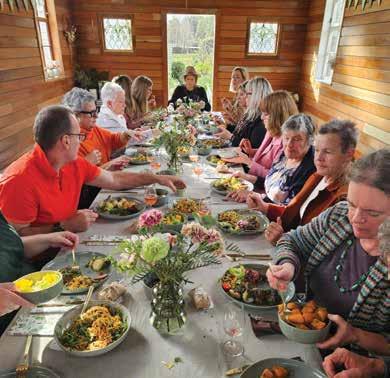

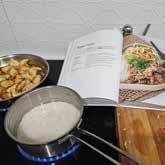

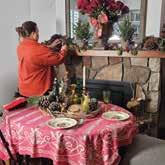

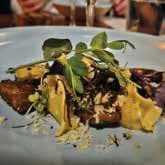
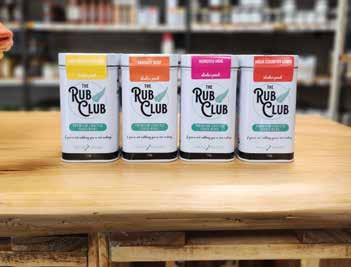
Created as a passion project by Ryan Burke, a trained chef, BBQ enthusiast and co-owner of Red Kitchen Cafe, Rub Club’s range of rubs and spice mixes are designed to elevate your food.
The range includes four main spice blends: Top Notch Chicken, Smoky Beef, Horotiu Hog, and High Country Lamb. Ryan says he adds some of the Top Notch Chicken to his mac and cheese and “the kids love it”. Another tip is to mix the Horotiu Hog with Wild Country Fine Foods American Mustard to help the spice stick to your ham, meat or veg.
Available at Red Kitchen Café & Store in Te Awamutu and online at therubclubnz.com

3.
Among the treasure you’ll find at The Heritage Trading Company in Cambridge is a range of beautiful jewellery. Carefully sourced from a select group of experienced suppliers, each piece undergoes meticulous cleaning, inspection, and repair when necessary. Plus, for items valued over $600, they provide a registered valuation.
Embracing vintage and antique jewellery isn't just about owning a beautiful piece; it's also a sustainable choice, contributing to a more eco-conscious lifestyle.
Alongside their vintage pieces is a range of beautiful lab grown diamonds in silver settings giving you another sustainable choice.
Rediscover timeless elegance and sustainability with The Heritage Trading Company, 40 Duke St, Cambridge.
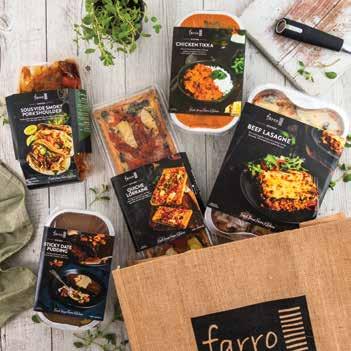
2.
You no longer have to take the chilli bin when you go to Auckland to stock up on Farro fresh meals as The Store in Cambridge now stock a large range of these.
Made with fresh quality ingredients you would expect from the Farro crew, there are a wide selection of meals to choose from, including single serve options and desserts.
Think lasagnes, mushroom and ricotta cannelloni, smoked fish pie, chicken tikka, potato or cauliflower gratin, chocolate self-saucing pudding and more.
Head into The Store to check them out at 41 Duke Street, Cambridge.
4.
Food waste is a real problem, one we try to highlight often here at Nourish and there is no reason this shouldn’t apply to alcohol too. The clever folk at Strange Nature Gin have turned the alcohol extracted from wine when making 0% wine into award-winning gin. Now that’s exactly what your nan was talking about when she said waste not want not! And you can now enjoy a New Zealand gin while feeling virtuous because you are helping reduce waste.
Add to this it comes in a stunning bottle you won’t want to throw away.
So what does it taste like? Like the Sauvignon grapes it is derived from –aromatic and fruity; part tropical and zesty, part herbaceous.
www.strangenaturegin.com



Proving Waikato producers are some of the best, Expleo Butchery was recently recognised at the NZ Pork and Bacon awards, named champion for their dry cured streaky bacon and sliced ham as well as picking up a sliver for their boneless ham.
Meyer Cheese received a gold for the King of Cheese Parmesan at the International Cheese awards.
Hunt and Gather Bee Co’s Chai Spiced Honey was awarded a gold star at the 2024 international Great Taste awards in London.
Hayes Common have continued their streak also, being named yet again as one of the finalists (out of 170 eateries around the country) in the Toastie Takeover with their Turkish Reubenstein.
And Grey Street Kitchen Barista Bryan Rajeyya won the Latte Art Championship of New Zealand.
The Pickles crew are gearing up for a great summer with the addition of a retractable roof over their outdoor area. This prime spot with views over the river has long been one of the best outdoor dining options in Hamilton, now with protection from the weather plus new seating and a portable bar coming. Co-owner Mat Pedley says the space can be used much more, including for events.
298 Victoria Street, Hamilton Central
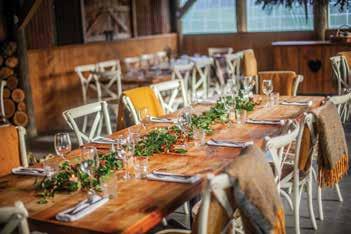

The Falls Retreat are hosting a very special Christmas luncheon focusing on consuming more mindfully over the Christmas season. Bestselling author of Living Lightly, Nicola Turner will share inspiring stories, practical tips and time-saving hacks to simplify your life and help you make more sustainable choices meaning less stuff, less waste and less impact!
Sunday 24 November. Tickets are $149 per person, includes morning tea, interactive and entertaining session with Nicola Turner (www.mainstreamgreen. co.nz), followed by a delicious seasonal lunch. Plus, you get to take home a copy of Nicola’s book.
Tickets at www.fallsretreat.co.nz
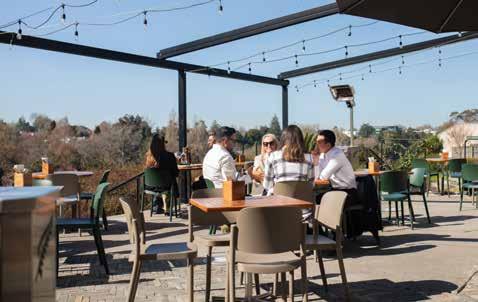

This is the cake I pull out for most birthday celebrations, so why not for Nourish's 14th birthday edition. One, it’s very easy to make, and two, it stays beautifully moist for several days, so you can easily make it a day or two ahead of time. It freezes well and if you have a large party in mind, double the mix and cook in a large baking dish for a sheet cake that is easy to decorate and slice.

1¾ cups flour
2 cups sugar
¾ cup cocoa
1½ tsp baking powder
1½ tsp baking soda
½ tsp salt
3 eggs
1 cup milk
½ cup oil
1 tsp vanilla extract
1 cup boiling water
GANACHE
250g dark chocolate, chopped
25g butter, diced
160ml cream
Place all the dry ingredients into a bowl and mix well. Add the eggs, milk, oil and vanilla and mix with an electric beater on medium for 2 minutes until smooth. Finally, stir in the hot water.
Pour the batter into a greased 21cm round cake tin and bake at 165°C for approximately 1 hour or until a skewer inserted comes out clean.
Note: The batter will be very thin, which causes problems if you are using a spring form tin. If you don’t have a cake tin with a solid base you will need to line the outside of the tin with a couple of layers of tin foil to stop the batter from oozing out. As insurance I would also put the cake tin on an oven tray just in case.
Place the chocolate and butter into a bowl. Heat the cream up in a small saucepan or the microwave until almost boiling. Pour the cream over the chocolate/butter and allow to stand for 5 minutes. Whisk until you have a smooth ganache, then refrigerate for about 30 minutes, stirring often.
Once the ganache is cooled but at a spreadable consistency, place it into a stand mixer with a whisk attachment and beat until light and fluffy.
Spread a thin layer over the top of the cake, then transfer the mix to a piping bag with a round nozzle and pipe kisses on top.
If the ganache sets on you too quickly, you can melt the mix down, cool and whip it up again.
This and nearly 100 other recipes we know you will love is in our Nourish, The Cookbook, vol 2. Head to our website to get your copy, use the code 'BIRTHDAY' to save $14 and get free postage.
nourishmagazine.co.nz/shop
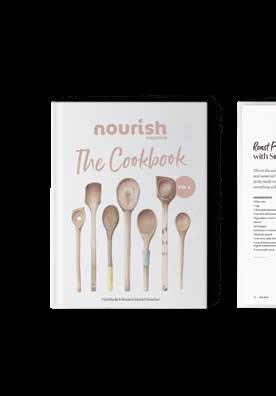
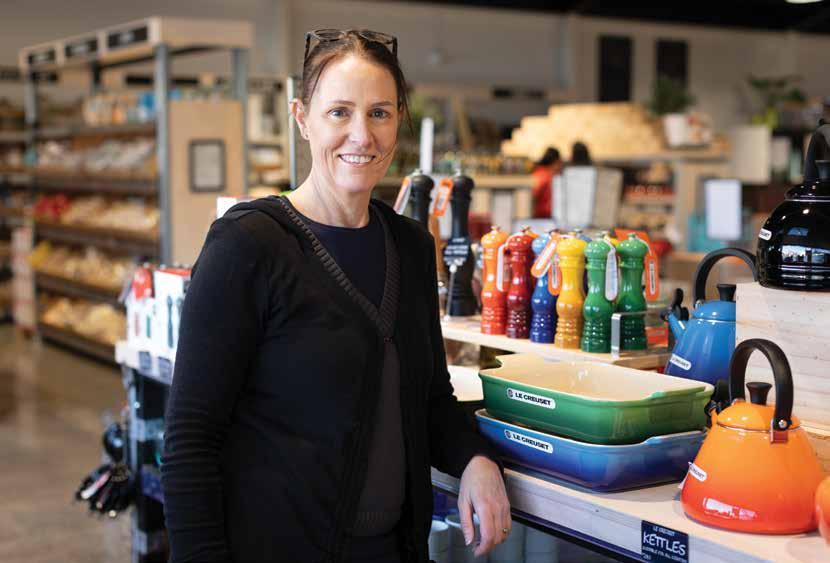
On September 14, bang on the fourth birthday of Hamilton’s Vetro store, owner Anna Greentree will celebrate with a spring festival outside her building on Rostrevor Street. “We want to bring people together for a good time,” she says.
The programme includes live music, stalls stocked by some of the city’s specialty food makers and suppliers, and a display of European cars. You can meet friends for lunch, or just browse and buy, happy in the knowledge that this portion of the street will be closed off from 9am to 4pm. The only cars in sight will be the enviable European jobs.
There will be pizza, paella, breads, French pastries and chocolates, European sausages and more, as well as in-store sampling of Italian wines, coffee and cheese. Anna has imported a 40kg wheel of Italian Parmigiano Reggiano especially for the festival and it will be cut on the day, available for tasting and purchasing. “It’s the real thing, perfect for pasta or risotto.”
Vetro Spring Festival is held in conjunction with the Hamilton Central Business Association, and it is Vetro’s second festival, the first held in 2021. Anna says Hamilton is the country’s best-kept secret, it’s a great place to be part of, and she loves the opportunity to support the CBD association and showcase some of the city’s artisan food suppliers.
In 2020 Anna and husband Daryl opened Vetro Mediterranean Foods, part of the North Island-wide Vetro co-operative buying group started in 1999 by the late Jan Patulski, and they pride themselves on stocking quality foods at affordable prices from Mediterranean and New Zealand producers.
The Hamilton Vetro project was well underway when the country went into the first nationwide Covid pandemic lockdown, in March 2020. It was a challenging time for Anna and Daryl, and some people thought they were mad to continue amid such economic uncertainty.
Anna says they remained positive. They opened six months after the first lockdown and they’ve built a solid base of customers and a great team of staff. “We know many of our customers by name. We’ve become part of people’s cooking repertoire. We’ve grown into ourselves here. We have thousands of products on our shelves, a diverse range of customers, and we’re good at sourcing hard-tofind items.”
When people began travelling again, post-Covid, Anna noticed people dropping into the store on their return to buy the wine, cheeses, pastas and items that they’d loved in Europe. Vegans, vegetarians and others with dietary requirements often find suitable products at Vetro, and home cooks perhaps making spaghetti carbonara for dinner are pleased to find guanciale in Vetro’s deli, Italian pork cheek bacon that is the traditional ingredient for this dish.
“Our customers are so knowledgeable,” Anna says. “We learn from them all the time.”
Four years on, there seems like a lot to celebrate at the Vetro Spring Festival.
Vetro Spring Festival, Saturday 14 September, 122 Rostrevor St, 9am–4pm.

CURRENT FAVOURITE VETRO DINNER?
Italian Granoro Conchiglioni pasta. The shells are big enough to stuff and bake: I parboil the shells and fill them with a mixture of gently fried onion and garlic, Zany Zeus mint feta, ricotta, finely chopped spinach, an egg to bind, nutmeg, salt and pepper. Place the filled shells on a bed of passata, in an oven dish, dot with some small fresh mozzarella balls and bake until lightly golden and cooked. Delicious.
BEST SELLERS?
Our canned tomatoes: Chopped tomatoes, cherry tomatoes, tomato paste – they all fly out the door. Bottled Greek peaches are big sellers, too, as well as our pastas, Turbo Tonics (turmeric, ginger and lime concentrate), Fowlers Eggs, and ciabatta from The Grumpy Baker on Victoria Street. We’ve been selling Grumpy Baker bread almost since we opened, and they’ll have a stall at the spring festival.
BEST NEW PRODUCT?
Bella Sundried Tomato Paste, $4.99/360g: Chopped sundried tomatoes in olive oil with garlic and herbs, a Turkish product with great depth of flavour and colour. It is so versatile. Add it to a scone mix, to any pasta dish, use it as a pizza base, a sauce for sausage rolls, or stir into hummus, yoghurt or mayo to create a great dip. One of our staff eats it straight from the jar with a spoon!
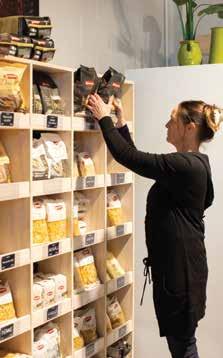


UNSUNG HEROES?
Our fish shelves: We stock outstanding tinned fish: Baltic sardines, big chunky pieces of tuna, and wonderful Italian anchovies. There are some excellent (and nutritious) meals to put together here.



PRECISION CUTTING & PROFESSIONAL COLOURS
We use and recommend:

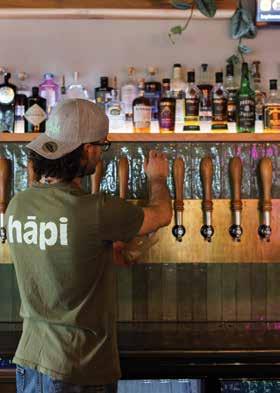


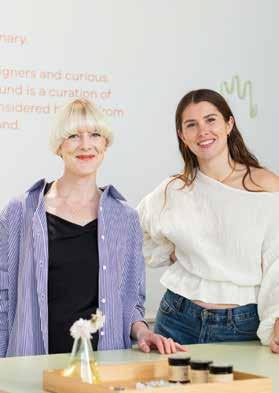



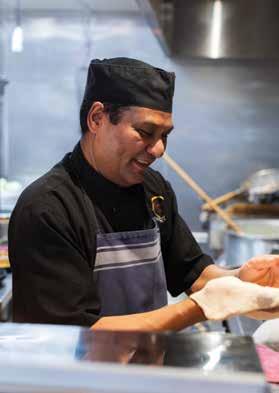

I’ve been a Made Market regular since opening day last November, joining the vast crowds through its new front doors on Grey Street, Hamilton East, and probably contributing to the local traffic jam over that weekend.
There is a lot to like about the transformation of the rambling Waikato Regional Council building into a multi-level 21st century urban market, a one-stop shop with more than 40 owner-operated businesses. There’s an intrinsic small-town charm, where you get to know your favourite vendors, and the friendly chat along with your morning coffee, your packet of lamb koftas, your broccoli and bread, your hot porridge, or your drinks and dinner at the Mess Hall.
Made has settled in comfortably on Grey Street, developed its reputation and style, and close to one year on we’re asking its owners, and some of its vendors and customers, how things have been for them in this first cycle.
Made Market is the vision – and hard work – of Hamilton couple Matt and Jaimee Stark, and their team from Stark Property, so we start with them. They talk at a trestle table while little kids play on the market’s (stationary) red tractor and customers browse and buy. Peak days here are Friday, Saturday and Sunday.
Matt and Jaimee say the biggest win for them has been seeing how the city has responded to Made, in a positive way, as a place to be proud of. “It’s another thing to showcase in Hamilton,” says Matt. “It’s a labour of love for us and we want to ensure its success for everyone. It needs energy, and we’ve got energy to give.”
The first year, Matt says, is about finding your feet and this has been more challenging in an economic downturn. “But we’re doing pretty well, considering the environment. We’ve settled into the norm after the opening day crowds, growing consistency, growing businesses and customer relationships.”
There have been some vendor changes, a few who have perhaps not been in the right place have gone and others have replaced them. Matt says they work with those who may need to adapt, make changes. “It’s a family, really. We care about our tenants. We want everyone to succeed. We adjust and change if we hear concerns. We’re open to new things. It’s about getting the right mix.”
In the future there will be a new restaurant on the mezzanine, and Matt and Jaimee would like to see after-hours events at Made – Jaimee points to some great spaces for this – with food from the Mess Hall available. “For the moment,” says Matt, “we’re maintaining the status quo, supporting what we’ve got, striving for excellence.”
A couple of happy lunchtime customers have their say: Dallas Fisher and Mark Wylie have just finished plates of handmade gozleme from Turkish food outlet Mezze; this gets a big tick, along with other things they like.
Mark Wylie is CEO of food and event management company Montana Group and says he comes to Made for networking with colleagues and also with his family, sometimes meeting his daughters there after school. He likes Made’s artisan suppliers, “and it’s not just another food hall”.
“I haven’t had one single bad service experience here. Everyone is super-friendly and engaged. It feels like a nice little community.”
Dallas Fisher is co-owner and director of Montana Group, and he’s a Made regular. He shops for fresh ingredients for dinner, or something ready-made. He says there is great variety from places like the butcher (Expleo), Pirongia Mountain Vegetables, Red Kitchen, Soul Boul or Mezze.
He also mentions a mid-afternoon cocktail at Neat, the elegant outfit in the middle of Made that is the brainchild of Alex Hudson, owner of legendary Hamilton cocktail bar Wonderhorse.
Visitor Victoria Ridling praises Neat as well. She’s from Auckland, runs Union Post bar-restaurant in Ellerslie, and is visiting Made for the first time with friend Claire Ashton, from Te Aroha. Victoria likes the big shared seating space at Neat, thinks it’s a great idea, and she’s also very taken with Oat Bros porridge.
She and Claire are on their way to lunch in the Mess Hall, and Claire, who grew up in Hamilton, loves how Made opens up to the Waikato River views. “It’s so good to see this. That’s what Hamilton is all about.”
Brie Graham owns Asian-fusion outlet On a Roll in the Mess Hall. She loved the Made vision and the space from the beginning. “You get to see the river [from the Mess Hall]. We’re really lucky. This is a real drawcard for Hamilton. I had to be there. I absolutely love it.” Business, she says, has been very consistent, with a steady stream of people coming through.
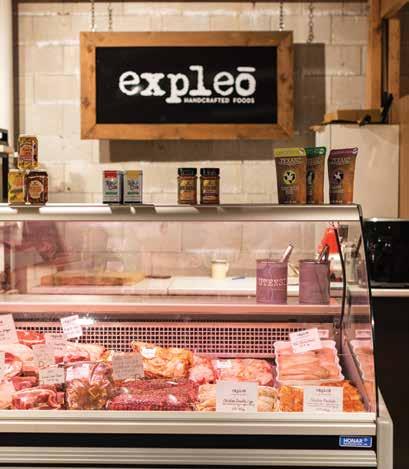

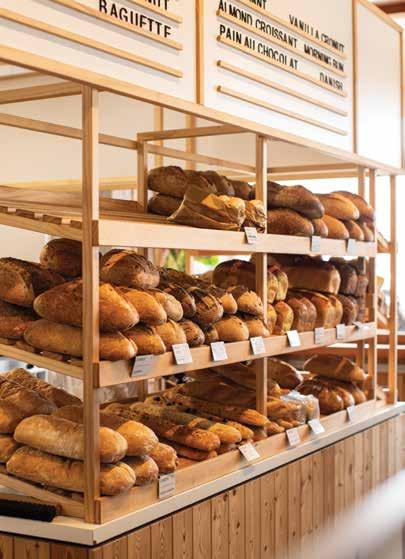
Local customer Vivian Pires has just had lunch at Mezze – “It was delicious” – and her Made favourites include Mezze, as well as Volare Bread and Mr Twist pretzels. She also likes the sustainable ethos and the incentive to bring your own jars to Bare Refill for grocery items.
“You get to know the vendors, and I like how the building doesn’t have many barriers. The open-plan space gives it a nice feel.” Today, she’s also bought produce from Pirongia Mountain Vegetables, which occupies an area laden with seasonal fruit and veges.
It is run by Crystal Robb and husband Adrien, in a co-relationship with Ngāti Haua iwi, and Tony Catos (of PMV). Crystal says that like many other retailers, they’ve felt the effects of the economic downtown, and business can be patchy.
“But people are trying to pull through and we’re doing okay. We need to be innovative and creative with what we bring to the store. We’re rebranding later this year as Peria Produce, expanding our plantings locally, and we have a number of fruit and vegetable trials going on. The vibe here is friendly and we are networking with other vendors.”
Bridie McNamara, owner of Bare Refill, also likes the Made community and it’s working well for her. “It’s mostly owneroperated. We get to know each other, and we’re well supported by the management.”
Bare is dedicated to supplying grocery items with minimum waste, as well as other products and homewares. Strong sellers include snacks, treats, loose-leaf tea, local Kaipaki Dairies milk and Dreamview yoghurt, and in the future Bridie has her eye on doing in-store events, including cooking demonstrations.
Up on the mezzanine floor, Ann-Maree Parsons and business
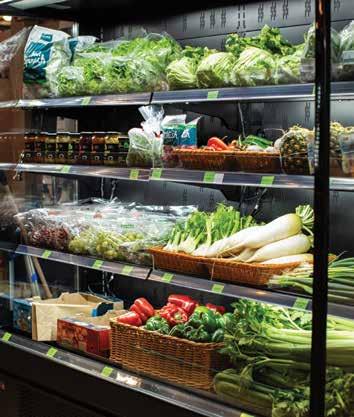
partner Liz Viviani run the spacious Found Store, selling clothing and homewares. Ann-Maree says they were in the Made pipeline from the beginning: “We had full trust in Stark Property’s vision for rejuvenating Hamilton East with this incredible hive of community activity.”
The pair was confident that Made would be welcomed by their existing clients and connect them to a wider demographic of visitors and locals. “The move has, at no surprise to us, paid off,” says Ann-Maree. “Our larger space allows us to host our customers the way we had always wished to through community events and styling appointments.”
And down in The Sheds, at the rear of the building, Karl MartinBoulton, owner-chef of eight-seater restaurant The Green, says it’s been a fantastic year. “We’ve been fully booked the whole time. To say I’m blown away by it would be an understatement.” He says Made itself is an incredible thing for Hamilton and the Waikato, and he can only see it growing. “The support from Stark Property has been great, and they’ve made it succeed. It’s a testament to them, 100 percent.”
Matt Stark puts the kudos back on his vendors: “Having all these people giving all this effort and energy to their businesses, it’s quite remarkable, really.”
401 Grey Street, Hamilton East madehamilton.co.nz

Denise Irvine
Denise Irvine is a born-and-bred Waikato journalist and foodwriter. Her work frequently showcases the region's talented chefs and food producers; she says we have the best of the best here.




SUBSCRIBE NOW AT www.nourishmagazine.co.nz/shop
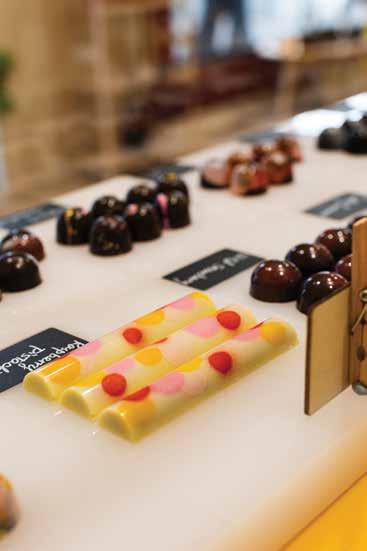
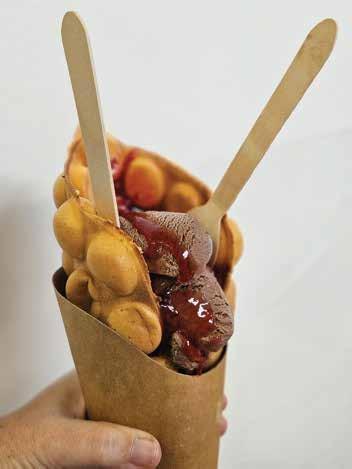
We’ve rounded up some of the best places in Hamilton central to satisfy that sweet tooth.
1. THIS LITTLE CAKERY - 6 Princes Street
Not just brownie but loaded brownies! Plus other decadent treats like doughnuts, macarons and cupcakes
2. BAMBOO SWEETS - Casabella Lane
One of the new kids on the block (or down the lane), but well worth seeking out for their boutique handmade chocolates.
3. THEOBROMA CHOCOLATE LOUNGE - Bryce Street entrance, Centre Place
From hot chocolates to handmade chocolates, every sweet tooth is satisfied.
4. GONG CHA - 11 Worley Place
Forget bubble tea, you need to try bubble waffles! Direct from Hong Kong, a rich warm waffle is wrapped around icecream and decadent toppings.
5. LA PROMESSE BAKE HOUSE - 5 Ward Street
For the best sweet pastries in town.
6. CREAM - 14 Garden Place
For truly tempting treats, from doughnuts and cinnamon rolls to decadent slices.
7. KOPI, RIVERBANK LANE - 298 Victoria Street
Not just great coffee, apparently the brownie is the best in town.
8. LE RENDEZ-VOUS - 113 Alexandra Street
Didn’t make it to the Paris Olympics? No problem, Le Rendez-Vous have a crêpe-load of tempting French treats.
9. DOT & WINNIES - 127 Alexandra Street
Yoyo, listen up, Dot and Winnies make the best melting moments in town.
10. SNOWTOWN - 104 Alexandra Street
Dessert like you have never tasted it. But why wait until dessert time. They’re open from noon Tuesday to Sunday.
11. MARKYLES CAFÉ - Hood Street
For the best custard squares around.
12. RAZZLE DAZZLE CAKES - 148 Ward Street
Sometimes the answer is cupcakes.
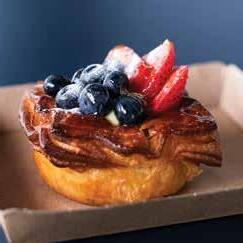
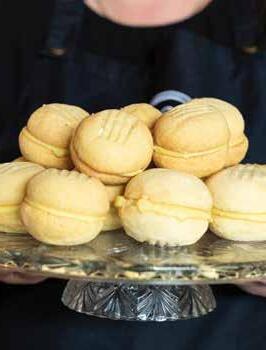
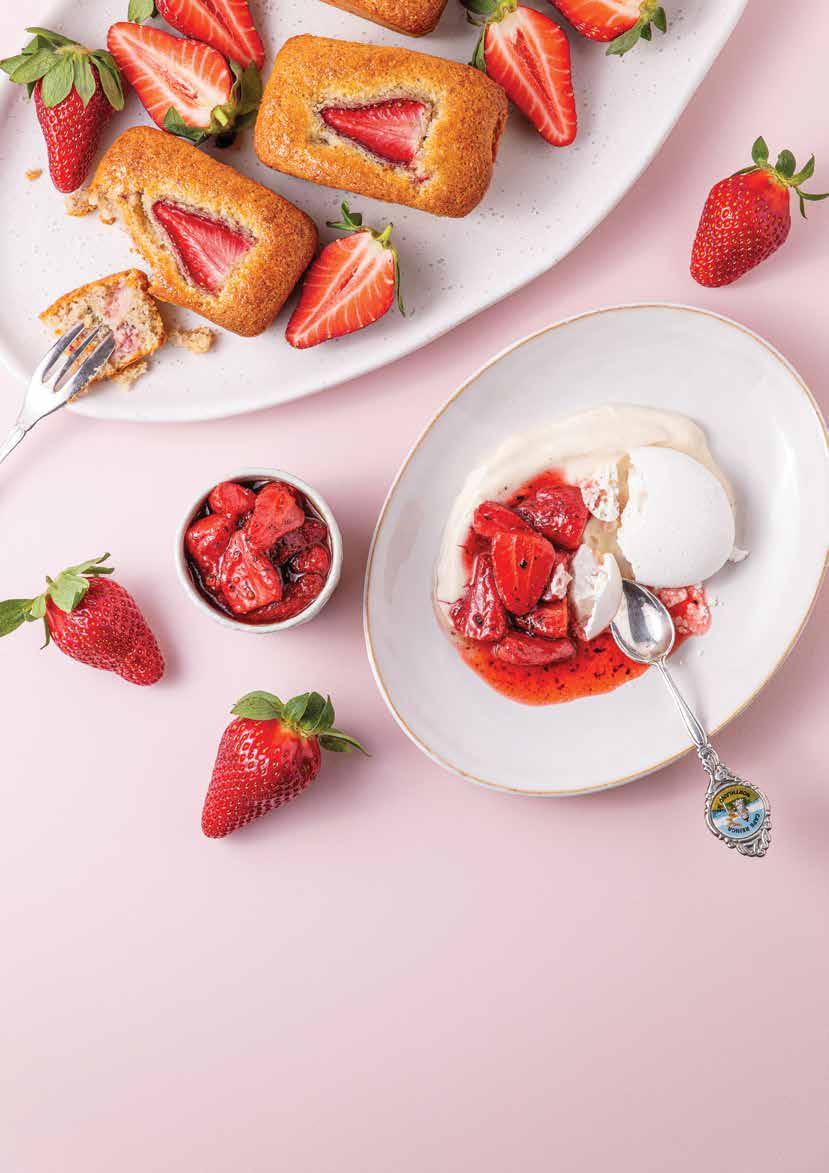
We are blessed to have easy access to plentiful, perfect strawberries straight from the berry farm throughout the Waikato and Bay of Plenty. These two strawberry desserts are a real treat.
This fully plant-based dessert is a little bit special. While appearing very simple, the flavours are a fantastic combination and lift the bar on what vegan dessert can be. Black pepper significantly intensifies the natural sweetness of roasted strawberries and adds some peppery warmth, and I’ve served the luscious little gems with a smear of boozy tofu cream (similar in flavour and texture to cheesecake filling) and meringue made with aquafaba (the liquid from a can of chickpeas) instead of traditional egg white. All of the elements can be made ahead, then assembled at serving time.
SERVES 4–6, WITH EXTRA MERINGUES LEFT OVER
ROASTED BLACK PEPPER STRAWBERRIES
250g strawberries, halved
1 tbsp maple syrup
1 tsp extra virgin olive oil
½ tsp freshly ground black pepper
AQUAFABA MERINGUE
¼ cup aquafaba
¾ cup caster sugar
1½ tsp cornflour
½ tsp vanilla paste or natural vanilla extract
½ tsp white vinegar
BOOZY TOFU CREAM
250g soft tofu
¼ cup raw cashews (soaked in very hot water for at least half an hour)
2 tbsp elderflower liqueur (or try kirsch or Cointreau)
2 tbsp maple syrup (or sweetener of your choice)
2 tbsp lemon juice
1 tsp vanilla paste or natural vanilla extract
¼ cup coconut oil, melted if solid
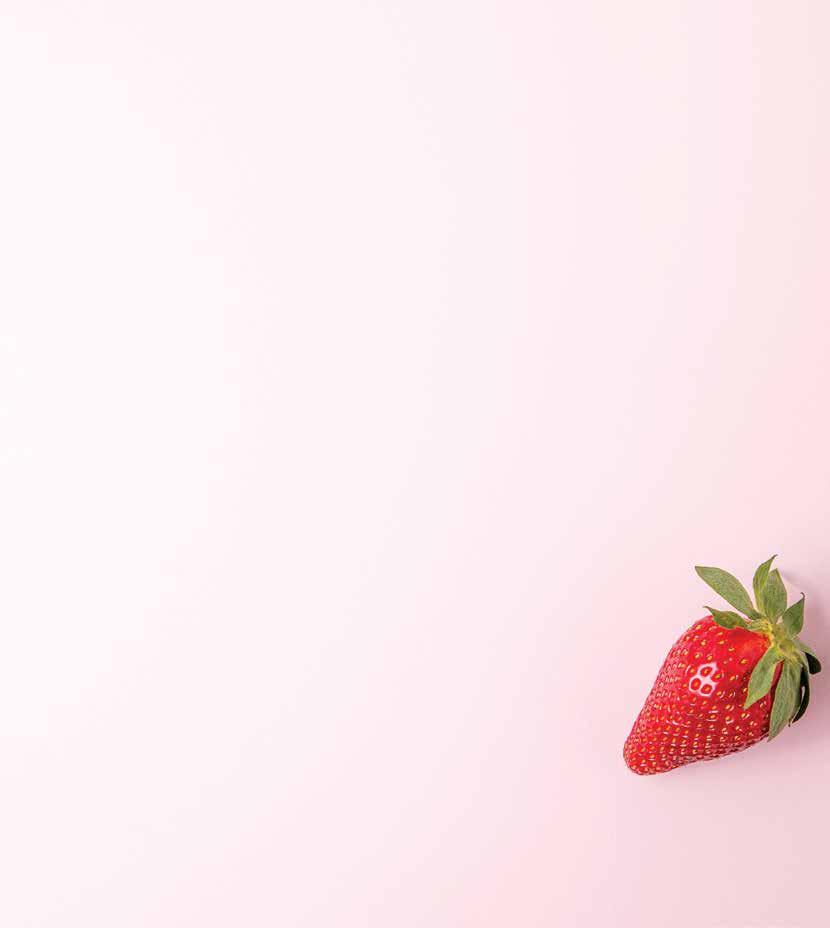
To make the roasted black pepper strawberries, toss them with the maple syrup, extra virgin olive oil and pepper and transfer to a lined baking dish. A smaller dish is best, so the juices can gather in a pool. Roast in a 180°C oven for 15 minutes, giving the strawberries a gentle stir halfway through. Transfer strawberries and syrupy juices to a bowl and cool. Cover and store in the fridge.
For the aquafaba meringue, start by beating the aquafaba in a clean mixing bowl until it starts to become foamy. Add sugar bit by bit and keep beating until stiff and glossy (about 10 minutes). Fold through the cornflour, vanilla and white vinegar. Spoon or pipe small mounds onto a lined baking tray and bake in a 120°C oven for 1½ hours, until the meringue is crisp and dry. Turn off the heat and allow meringue to cool in the oven. Store in an airtight container at room temperature.
For the tofu cream, blend tofu, cashews, liqueur, maple syrup, lemon juice and vanilla until completely smooth. While blending, drizzle in the coconut oil and blend for another 30 seconds or so, until the mixture is glossy and evenly combined. Scoop into a bowl, cover and chill for at least a few hours, until lightly set and scoopable.
To serve, smear a spoonful of tofu cream onto a plate and top with a scoop of strawberries and one or two meringues. Alternatively, break up the meringue and layer the three components in a tall glass.
Mission: free the food
Method: plastic-free groceries
Values: a cleaner planet
Wanna join the good fight?
Made Market | 401 Grey Street, Hamilton East
Hours: Monday - Saturday, 9am to 5pm | Sunday, 9am to 4pm
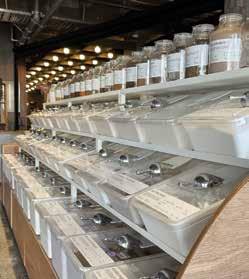


These adorable little cakes are light, moist, and fragrant with the scent of both strawberries and ground cardamom – a match made in heaven. They are quick to make and while fresh is always best, they’re an excellent way to use up the last few strawberries in the bottom of the punnet that might be a touch past their prime. This recipe uses a ‘flax egg’ to replace regular egg, which is simply freshly ground flax seed and water, which forms a light gel that’s an excellent binder. It’s worth the effort to grind cardamom seeds fresh for this recipe as the smell and flavour will be far superior.
WET INGREDIENTS
1 tbsp ground flax seed
3 tbsp water
½ cup plant milk (I used almond milk)
¼ cup neutral flavoured cooking oil (I used grape seed oil)
2 tbsp freshly squeezed lemon juice
DRY INGREDIENTS
¾ cup flour
¾ cup ground almonds
½ cup caster sugar
2 tsp baking powder
1 tsp ground cardamom
½ tsp baking soda
½ tsp salt
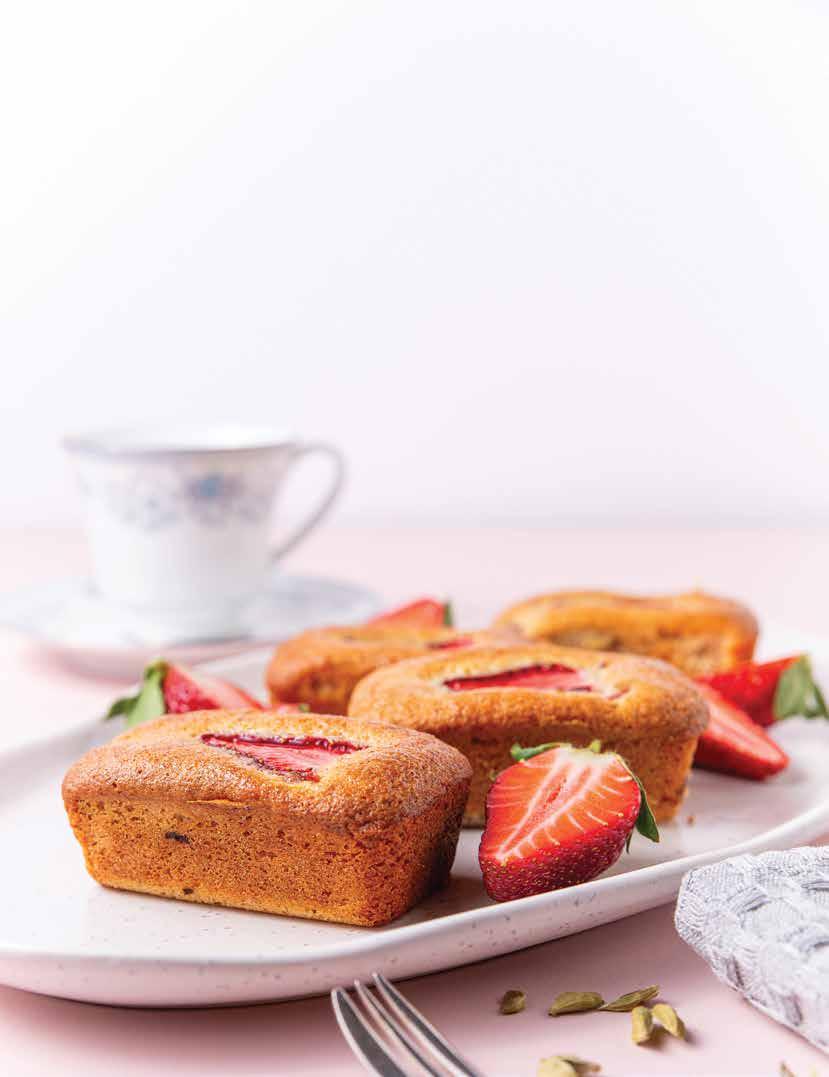
½ cup diced strawberries (about 3–4 strawberries)
2–3 strawberries, thinly sliced lengthways, for topping
Preheat oven to 180°C and prepare mini loaf or muffin tins by lightly oiling, and lining with a strip of baking paper to make cake removal easier later.
Mix ground flax seed and water together in a small dish and set aside for half an hour. I grind flax seeds in a coffee grinder, which makes short work of the job.
Mix flax seed mixture and other wet ingredients together in a mixing bowl.
Mix dry ingredients together in a separate mixing bowl, pour in the wet ingredients, ½ cup diced strawberries and stir gently to combine.
Spoon batter evenly into prepared mini loaf or muffin tins, then delicately arrange a thin slice of strawberry on top of each one.
Bake for 30 minutes, until springy and golden. The toothpick test doesn’t work well with these ingredients, so if you’re unsure of doneness err on the side of caution and go an extra five minutes to ensure they are fully cooked in the centre.
Remove from the oven and allow to cool in the tin. Optionally, you can choose to brush the tops with a little maple syrup or melted jam to add some extra sweetness and shine. Carefully remove cakes from the tin and enjoy.
These will keep in a sealed container in the fridge for 4–5 days.

Amber Bremner | Quite Good Food www.quitegoodfood.co.nz
Amber Bremner is the author of popular plant based food blog Quite Good Food. Her focus is on family-friendly recipes that are globally inspired and big on flavour, using seasonal produce and easily accessible ingredients.

A salad to show off spring vegetables at their best along with roasting intensifying their flavour.
For those gardeners out there growing broad beans, add a few blanched broad beans for extra goodness and texture.
SERVES 4
50g local walnuts, toasted
1 shallot, roughly chopped
2 cloves garlic, roughly chopped
3 anchovies in oil
2 large handfuls (50g) flat leaf
parsley leaves
1 large handful (20g) basil leaves
1 large handful (20g) mint leaves
3–4 tbsp extra virgin olive oil
juice of ½ lemon or more if needed
1 medium eggplant, trimmed
16–20 asparagus spears, woody ends trimmed
5 tbsp extra virgin olive oil
250g chip cherry tomatoes, halved
a few fresh basil leaves, torn if large
½ lemon, cut into wedges
Heat the oven to 220°C. Line 2 large shallow roasting trays with baking paper.
To make the pesto, put the walnuts in a food processor and coarsely chop. Add the shallot and garlic and process once or twice. Add the anchovies and herbs and process until the pesto has a coarse texture. Drizzle in the olive oil and lemon juice and process. Taste, adding salt to season and extra lemon juice if needed, or thin with a little cold water. Put into a small bowl, cover and keep in the fridge until ready to use.
Cut the eggplant into 2.5cm cubes and put into a tray. Drizzle with 3 tbsp oil and season with ½ tsp salt. Use your hands to mix together to coat the cubes evenly in oil. Or you could do this in a bowl and toss with a wooden spoon then tip into the tray.
Put into the oven and roast for 30 minutes until meltingly tender and golden. About 5 minutes before the end of cooking, scatter in the cherry tomatoes.
Put the asparagus into a tray in a single layer. Drizzle with the remaining oil then again use your hands to mix together to coat the spears evenly in oil.
Put into the oven on a high shelf and roast for 6–7 minutes until just tender. Remove from the oven and season with salt and freshly ground black pepper. Cut spears in half, if wished.
To serve, toss together the eggplant, tomatoes and asparagus and scatter onto a large plate along with the lemon wedges. Top with extra basil leaves.
Serve dolloped with the pesto or serve pesto separately, in a small bowl.
TIP - Scatter salad with fresh cheese such as burrata, stracciatella, stracchino or ricotta.

Kathy Paterson
A plentiful herb garden, citrus trees and a trial and error vegetable garden give Kathy the starting place for her recipes along with her love of the classics with a modern twist. Named one of Aotearoa NZ’s Top 50 Most Influential & Inspiring Women in Food and Drink 2024, Kathy is a food writer, recipe developer, food stylist and photographer. www.kathypaterson.co.nz
At first glance you might think these look like a bit of a fiddle to make, but believe me, they are so worth it.
The perfect snack and one that is on top of my list as soon as asparagus appears.
MAKES 12 (2 PER PERSON)
12 thick (fat) asparagus spears, woody ends trimmed olive oil for brushing
80g sliced pancetta
250g cream cheese (not lite cream cheese), softened
12 slices white sandwich sliced bread (preferably slightly stale), crusts removed
125g butter, melted
Heat a barbecue hot plate to medium-hot. Lightly brush the asparagus spears with oil then put onto the hot plate. Cook for about 5 minutes until nearly tender. Remove and sprinkle with salt and a little freshly ground pepper then set aside.
Put the pancetta slices on the hot plate and cook until just crisp. Remove to crumpled kitchen paper to drain excess fat.
Put the cream cheese in a bowl. Using your hands crumble in the pancetta.
Using your rolling pin, roll each bread slice to flatten. Spread the cream cheese mixture evenly on the bread slices. Put an asparagus spear at the edge (the one nearest to you), of each bread slice. Trim excess asparagus (these are the cook’s perk). Roll up, quite tightly into a cigar shape and press the top edge to secure well.
Wipe excess pancetta fat from hot plate, if necessary and lower the heat to medium.
Skim the white foam from the surface of the melted butter then pour the gorgeous dark golden butter into a small bowl leaving the milk solids behind.
Brush each asparagus roll up with butter and put on the hot plate. Turn regularly to brown and crisp the bread. Leave for a minute or two to cool slightly before eating.
To add a little heat sprinkle roll up with togarashi (Japanese red pepper mix), once crisp.
Use bacon instead of pancetta.
Leave out the pancetta and season the cream cheese with toasted and finely chopped walnuts. Or add chopped herbs such as parsley, chives and French tarragon.
Turn the bread crusts into breadcrumbs and freeze.
You can blanch the asparagus spears rather than cook on the hot plate.
Put the asparagus roll ups in a large baking tray lined with baking paper and put under a very hot oven grill. Turn to grill on all sides and watch as they are grilling.




WORDS VICKI RAVLICH-HORAN
Downey Designer Homes have been building dream homes in Hamilton and the wider Waikato region for 25 years. Owner Jeff Downey says, “When you build with us, you’re building a relationship with a successful family-owned business that not only has strong ties to the region, but also has a proven history of delivering fantastic homes within budget and on time.”
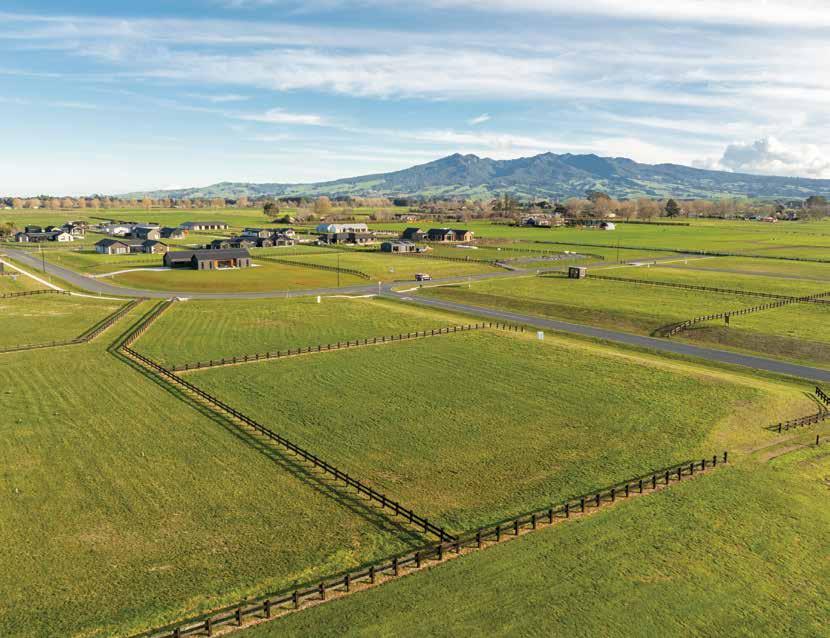
Traditionally you would contact the Downey team if or when you had a piece of land you wanted to build on, but they currently have a house and land package available in Matamata and Ngāhinapōuri. Downey Sales Consultant Kirsty Johnson says, “With views out to the Kaimai and Pirongia ranges, these manageable lifestyle sections boast the best of town and country living.”
Plus, Kirsty points out, Downey will take care of everything to ensure there are no surprises. “For us it’s about making it easier for people.” And here Kirsty reiterates Jeff’s point that as the experts in their field they can turn that plot in what is currently an empty field into the home of your dreams, on time and within budget. The sites they have selected in both Matamata and Ngāhinapōuri have been carefully chosen for their location and offering, being semi-rural but in close proximity to town.
Kirsty believes Ngāhinapōuri is great value. With a growing community and plans afoot for a new native walkway overlooking the Waipā River, this village offers a beautiful lifestyle opportunity just 15 minutes from both Hamilton and Te Awamutu.

Both plots are what is considered large lot residential and are perfect for those wanting enough space for a lifestyle and garden but don’t want to be tied to the land. Being semi-rural though the building process does come with a few more considerations, from septic tanks to driveways, but this is where the expertise of Downey comes in to ensure a smooth and enjoyable process.
“As lifestyle experts,” Kirsty says, “we know what it takes to design your new home. Whether you are looking to build something modern and contemporary or traditional and classic, we have a range of pre-designed plans that are well thought out, tested and successful for today’s style of living. Or you may like to design your own home using our team of experts who can transform your ideas into your dream property.”
Priced from $1,380,000.00 with titles issued and ready to go check out downey.co.nz or contact Kirsty today 021371347 or kirsty@downey.co.nz downey.co.nz



Dwight Egelhof is an Investment Adviser at Craigs Investment Partners, Hamilton. He recently shared how he helps his clients, what motivates him to help clients reach their financial goals, and a little glimpse into his personal life.
Dwight moved to Hamilton in 2019 from Auckland and is proud to call Waikato his home, where he and wife Carina are raising their daughter.
“My interest in investments began when I was really young. When just five years old my mum took me to the bank to buy some shares. As a result, I have experienced first-hand the difference this has made in my life. Seeing how I can help others do the same is my key driver in what I do today.”
Dwight explains that he is passionate about helping clients achieve their financial goals. “The investment plans we build are based on what matters to our clients, with personalised solutions every bit as unique as they are, and the investment advice I provide is backed by our research team’s indepth market insights.”
“Along with the commitment to clients for the long-haul, we also take huge pride in supporting the communities we serve. Being part of and contributing to the local community is hugely important to me. I am currently the Chair of the Hamilton Central Business Association, where I have been a board member for five years. I am also a Trustee of a great local charity – the Cake Detective.”
Whether you are ready to invest right now or are thinking you need some advice to help prepare for your financial future, give Dwight a call on 07 981 2556 or email dwight.egelhof@craigsip.com.
Craigs Investment Partners Limited is a NZX Participant firm. Dwight’s adviser disclosure statement is available on request and free of charge. The Craigs Investment Partners Limited Financial Advice Provider Disclosure Statement can be viewed at craigsip.com/terms-and-conditions. Please visit craigsip.com.

Name: Dwight Egelhof
Profession: Investment Adviser at Craigs Investment Partners
What you enjoy: In my downtime I love to cook, ideally barbequing, and spending time in the outdoors. I also genuinely love getting to know my clients and how I can help them achieve their goals, so give me a call for a coffee and a chat. How to get in touch: Contact me on 07 981 2556 or at dwight.egelhof@craigsip.com.
Skycity Hamilton 346 Victoria Street
palaterestaurant.co.nz

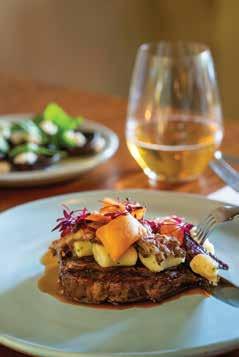



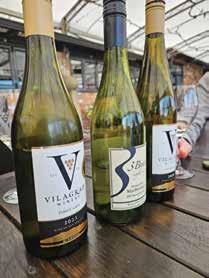

People often think my life is very glamourous, filled with events, long lunches and the like. The truth is there are an awful lot of dishes, eating leftovers and time spent in front of a computer. Although I can see where the confusion lies when my feed is filled with days like our recent Audi Day Out.
A couple of lucky Nourish VIPs and Ebbett Audi clients joined me for a day out in the Waikato. We started at Ebbett Audi where we picked up our rides for the day, the fully electric and super smooth Audi e-tron S Sportback and very cool Audi Q8 S-line 55 TFSI.
First stop on our iconic Waikato foodies day out was Vilagrad's. Here, Kristian Nooyen, one of the three brothers and the third generation continuing to grow this 100-year plus family business, showed us around. If you’ve been to one of Vilagrad’s famous Sunday lunches or celebrated a wedding here, as head chef, it was Kristian’s food you enjoyed.
We’ve arrived on a busy day with the restaurant closed for the weekend as the team spring clean, paint the kitchen and waterblast the vast marquee that now acts as the main restaurant. Despite this going on Kristian generously shows us around the winery and cellar before we sit down to enjoy a few medal winning drops.


With a few bottles in hand for later, we take a short drive to Meyer Cheese, parking the Audis beside some very cute new additions to the farm, baby calves. Not normally open to the public we have timed our visit perfectly, as the team are not busy making cheese, meaning we can get the full tour from farm and miking shed to the cheese factory just 100 metres away.
After explaining what makes Meyer different and their cheese so good (the happy healthy cows and freshest, best quality milk) we enter the cellar to taste for ourselves why Meyer Cheese is one of the most award winning cheesemakers in New Zealand.
Adding some cheese to our wine stash in the boots of the Audis we nip over the hill for a smooth ride to Raglan. Parking on the wharf, we catch up with another Waikato icon – Tony Sly.
Since the 80s, Tony’s iconic pottery has been a favourite of many foodies from the Waikato and beyond. His plates often grace the pages of Nourish spreads and our group get to have a peek at how the pieces come together, before we peruse the shop to discover what’s new.
With tummies rumbling, our final stop is The Shack, where coowner and head chef Justin has created a feast for us to enjoy. The raw kingfish with lime, coconut, cucumber, coriander and finger limes elicits sounds of joy. For me, the bang bang brassicas are

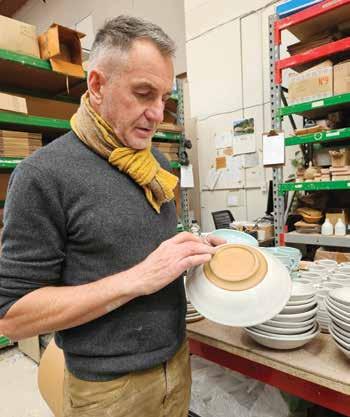
bang on and I’d be happy with just a plate of these!
But there is more to try. Lamb shoulder with caper parsley emulsion has some wiping the plate clean, while the zucchini and haloumi fritters with harissa tempt me even though I am full. And just as we are exclaiming this to be the case, Justin’s wife Alex tempts us all with an array of cakes from the cabinet.
What a perfect way to end our wonderful day out in the Waikato. It’s just a shame the Audis aren’t self-drive, as we all now feel like a bit of a snooze!

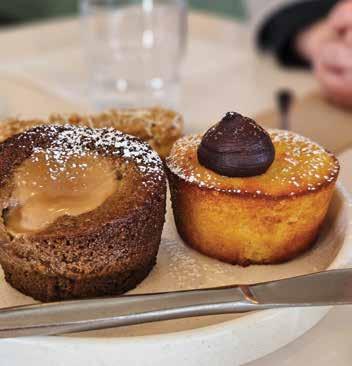
Book your own Audi test drive at www.ebt.nz/ebbettaudi
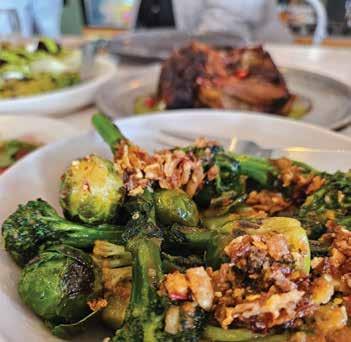




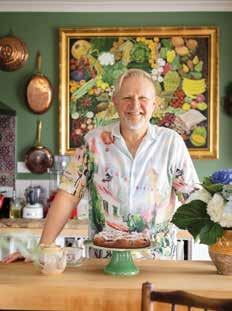
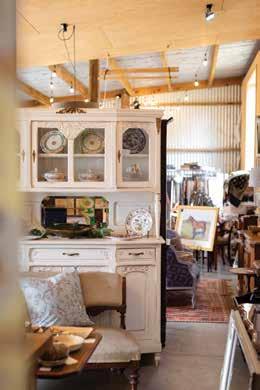

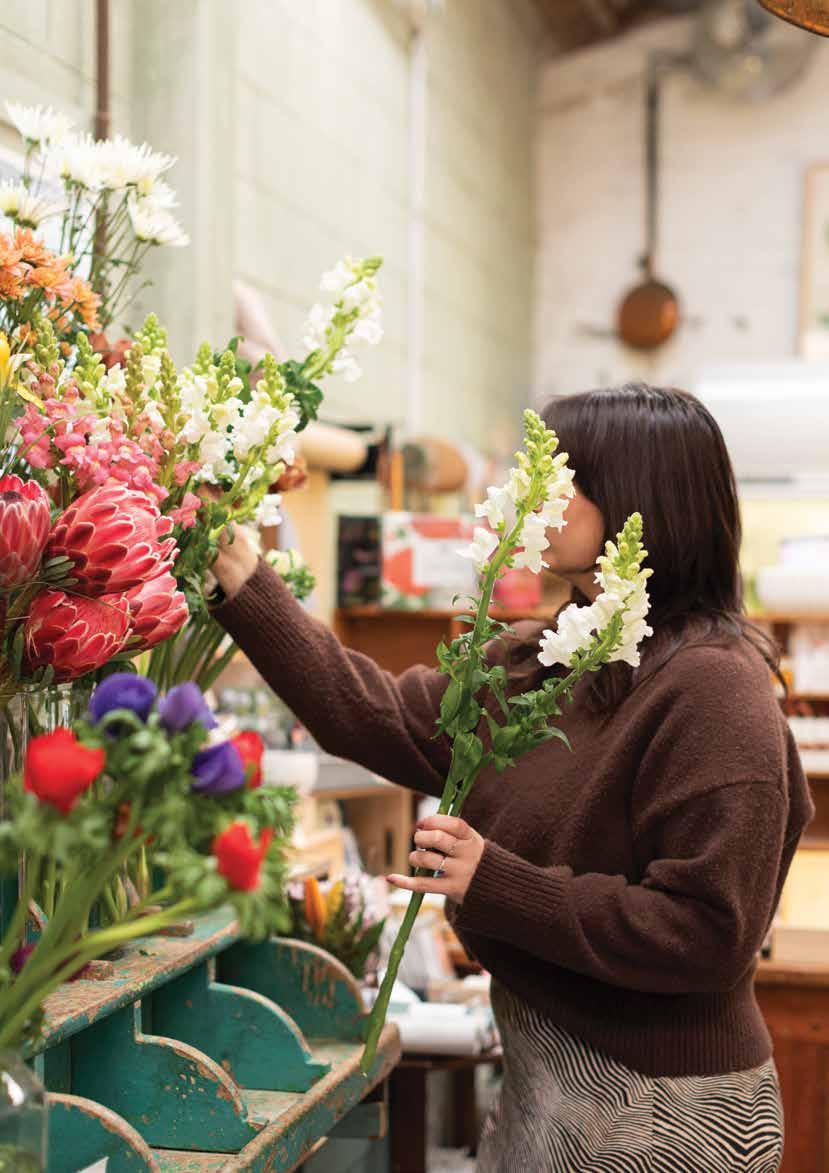
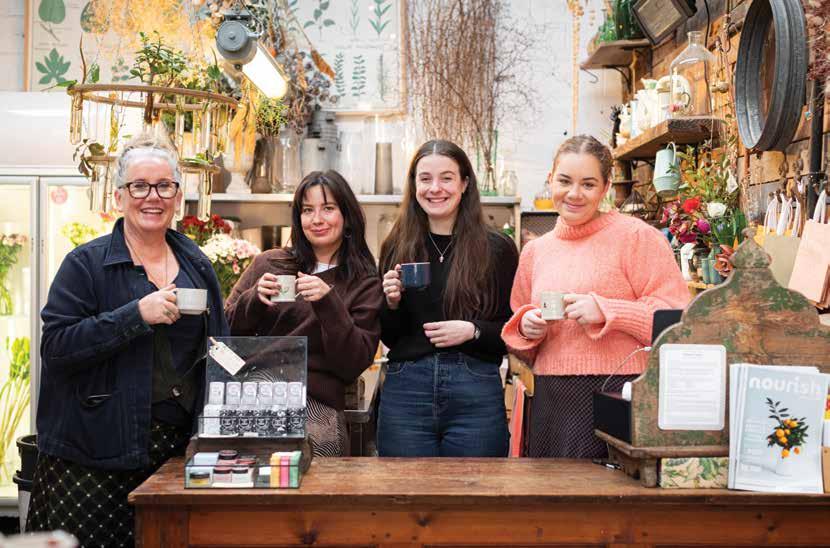
Alex Bedford, owner and director of The Flower Crate, cradles her handmade Richard Beauchamp stacking mug, admiring its aesthetic qualities. She has returned from neighbouring café Space Cadet, also down Lovegrove Lane, off Grey St in Hamilton East, with her two staff’s morning coffee in an assorted collection of cups.
This seemingly small action speaks to Alex’s ethos; supporting makers and business owners who follow best practice, creating really cool relationships with suppliers, and stocking unique, thoughtful ethical wares. Alex’s stance on sustainability is the core across the three strands of her business; The Flower Crate’s fresh cut flowers, and gift store and The Potting Shed .
Alex was born in Ireland, raised in England and came out to Hamilton, with her parents, where she later completed a degree in Ecology and Zoology. She and her husband moved back to the Waikato where she owned her own store and worked in sales before raising three children. It was during her youngest daughter’s last year of school that Alex started seriously looking for an opportunity to retrace her desire to own her own business after working in retail for others. Strolling down Lovegrove Lane after coffee, her friend mentioned that The Flower Crate was for sale, which led to Alex meeting with Sandra Bai who had established the business three years prior.
Alex describes the timing as both “extraordinary & serendipitous” despite the challenges of opening a business in 2020 during lockdown. Alex had Sandra at her side for a six-month handover period which she describes as invaluable and was able to make incremental changes while the doors were shut. Of course, indoor plant sales went crazy over this time and Alex, who comes from a
long line of gardeners, is happy to give advice and is constantly learning herself.
The Flower Crate only stocks New Zealand grown flowers, from local growers wherever possible, which are wrapped in brown kraft paper that can be repurposed or recycled. She uses reusable bamboo cloth wrap and compostable bags as a wet wrap protection to prevent the flowers from becoming stressed between the shop and their destination. Alex takes home the accumulated green waste to compost and encourages customers to compost spent flowers rather than sending to landfill. One thing you will never find used is oasis foam, a type of plastic commonly used to hold together arrangements which Alex describes as her personal bugbear. Instead she and the team carefully consider the mechanics of displaying flowers, such as on a casket spray or wedding installations, using natural materials.
She feels proud of what she has achieved over the past four years and still has many plans to expand the ranges she stocks. “We’ve created something quite niche in Hamilton and I think that people like coming here because what we have isn’t in every other shop.” Alex cites Gisborne based Ora Aromatherapy, a natural skincare company, which she describes as “beauty for the soul.” She also stocks Australian products which cannot easily be found locally. The store is constantly morphing in order to accommodate those special items that she’s come across, through travel or social media, that catch her eye and would like to stock. Alex jokes that people need to take in the store in three rounds. “Look down, look mid and look up!”
Being on Lovegrove Lane alongside other boutique businesses is important to Alex who feels connected to this neat community of local, likeminded owners.
Backed by loyal staff of which Alex’s daughter Phoebe has been a familiar and friendly face from the start, and a handy husband who

has spent many "free hours" refitting the shop, she is extremely grateful for the continued support and knows success comes from all around.
When it comes to the shop she says, “We’re evoking a memory, which is what I wanted to achieve, so that when people buy or are gifted something they are taking on the story of the creator and in that story, I am the connector.” Take one of Richard’s beautifully crafted cups, handcrafted in Ōtautahi | Christchurch and stocked exclusively at The Flower Crate. Alex can speak about him, his background in the coffee industry and how his bespoke works are made.
“My hope is that when people drink out of that coffee cup there is a link to its maker and its story.” __
The Flower Crate
1/394 Grey Street, Lovegrove Lane, Hamilton East www.theflowercrate.co.nz

Megan Lyon
Megan grew up on the Coromandel with an abundance of freedom and creativity. Studying arts led her to Kirikiriroa, Hamilton where she returned to having run a dealer gallery in Tāmaki Makaurau, Auckland.
Happily stationed in Hayes Paddock, with her husband and two boys, Megan has directed an international arts festival for a decade and freelances installing artwork and writing for several national publications.

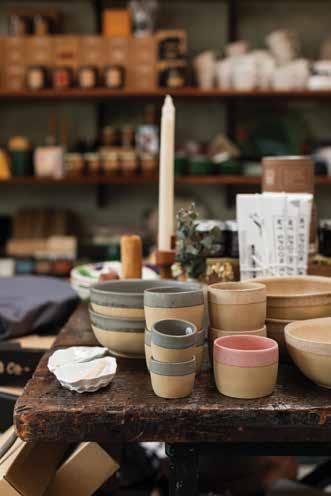
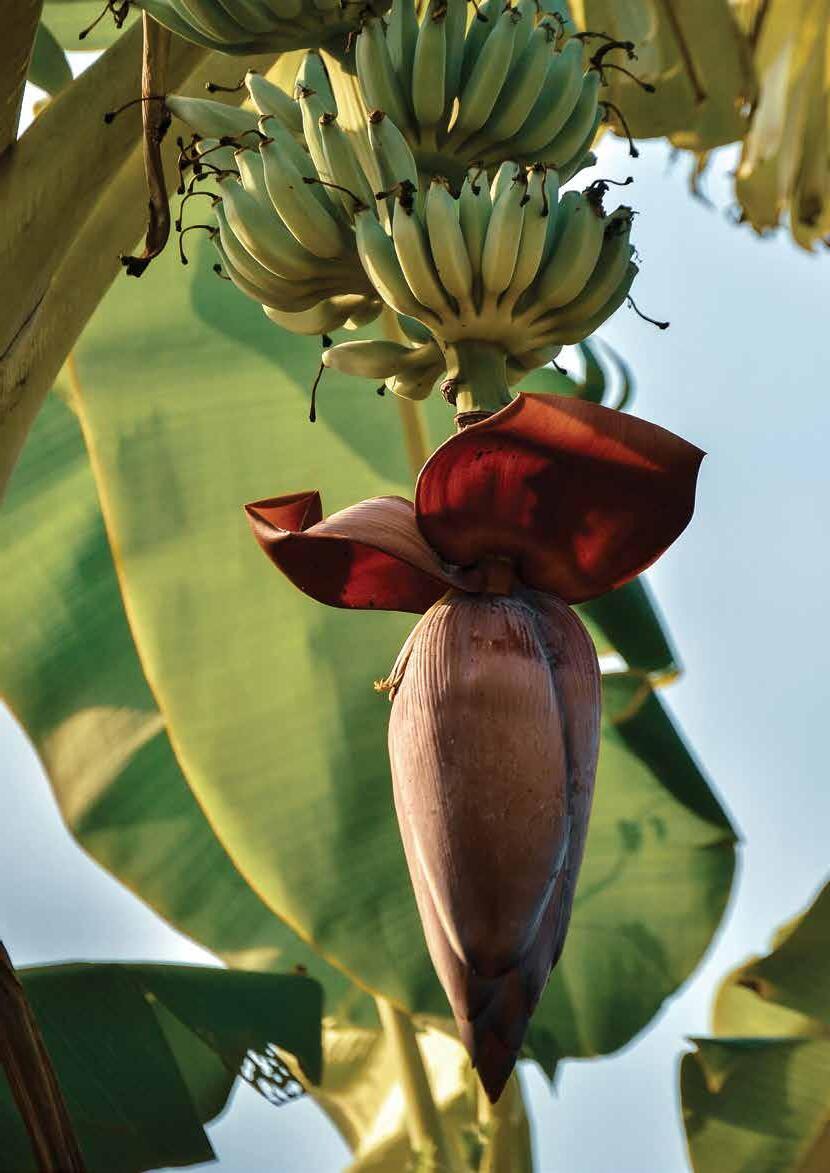
When I was 15, I went on a student exchange trip to Australia. Can you guess what I snapped my first tourist photo of? No, it wasn't the Sydney Opera House or a kangaroo or koala, but The Big Banana statue in Coffs Harbour.
Fun fact: Our Aussie cousins grow all their own bananas, whereas we import a whopping 72 million kilograms every year from Ecuador and the Philippines.
Another fun fact: According to Statistics New Zealand, we spend more money on bananas than any other fruit – about $130 per household per annum, more than twice what we spend on their closest competitor, apples. Indeed, we're so bananas about bananas that we eat more of them per capita than any other developed country.
In Northland and Gisborne, enterprising horticulturists are attempting to establish commercial plantations of bananas and pineapples, but anyone with a frost-free garden – or a glasshouse or large conservatory – can try to grow their own. The main variety available to home gardeners is Misi Luki, better known as lady fingers. These bananas are smaller than the commercial Cavendish variety sold in supermarkets, being closer in size and shape to the chubby Bobby Bananas marketed as school lunchbox snacks. (These are just the little ones plucked from the end of each commercially grown bunch.)
Bananas are subtropical and as such need full sun, compost-rich soil, lots of mulch, shelter from shredding winds and plenty of water over summer. Feed potted bananas regularly with liquid fertiliser or use slow-release citrus fertiliser in spring or summer.
Although we think of bananas as palm trees, their trunks are actually giant pseudostems made up of layers of fleshy leaf sheaths from within which a downward-facing flower stalk pops out after a couple of years. The fruiting blossoms emerge in groups or ‘hands’ that spiral around this main stalk. In the wild, these flowers are pollinated by fruit bats, but all the commercially grown varieties have been hybridised to the point where the fruit forms without any help on the fertilisation front.
Once a few clusters of bananas have formed, snap off the pointy end of the flower so all your plant’s energy goes into fattening up
the fruit. After a few months, you can then either sever the whole bunch to take into a warm room indoors to hang and ripen, or tie a woven plastic sack over the fruit (to trap the natural fruit-ripening gas ethylene inside) until it starts to turn yellow.
Homegrown bananas ripen like avocados – one day they're unripe, the next they're overdone – so keep an eye on them, because once they start colouring up, there's no stopping them. The hands ripen in relay, starting with the biggest (oldest) fruit at the top.
After fruiting, the original pseudostem will start to die down, so channel your inner Karate Kid and chop it down with a machete, hacking up the bits for mulch or compost. New side stems will soon appear and off you go again!
If life hands you battered or bruised bananas, you can always make banana cake – though I tend to recycle our overripe fruit in jars of rhubarb and banana jam. You'll have to take my word for it that what this murky jam lacks in aesthetic appeal – pretty much everything – it makes up for in flavour, though you can always add a dash of red food colouring for a prettier pink preserve.
Chop 750g ripe red rhubarb into 2cm pieces. Place rhubarb in a bowl, sprinkle with 750g sugar and stand overnight. The next day, scrape the rhubarb and sugar into a medium saucepan. If the rhubarb hasn't released enough juices, add 1–2 tablespoons of water. Heat gently until boiling, then add the juice of a lemon and simmer for 10 minutes. Stir in 2–3 mashed bananas then boil for a further 5 minutes. Pour into jars and seal.

Waikato born-and-raised gardening journalist Lynda Hallinan lives a mostly self-sufficient life in the foothills of the Hunua Ranges, where she has turned a former sheep paddock into an organic no-dig vegetable garden at Sweetgum Cottage. Her garden is open to the public by appointment.

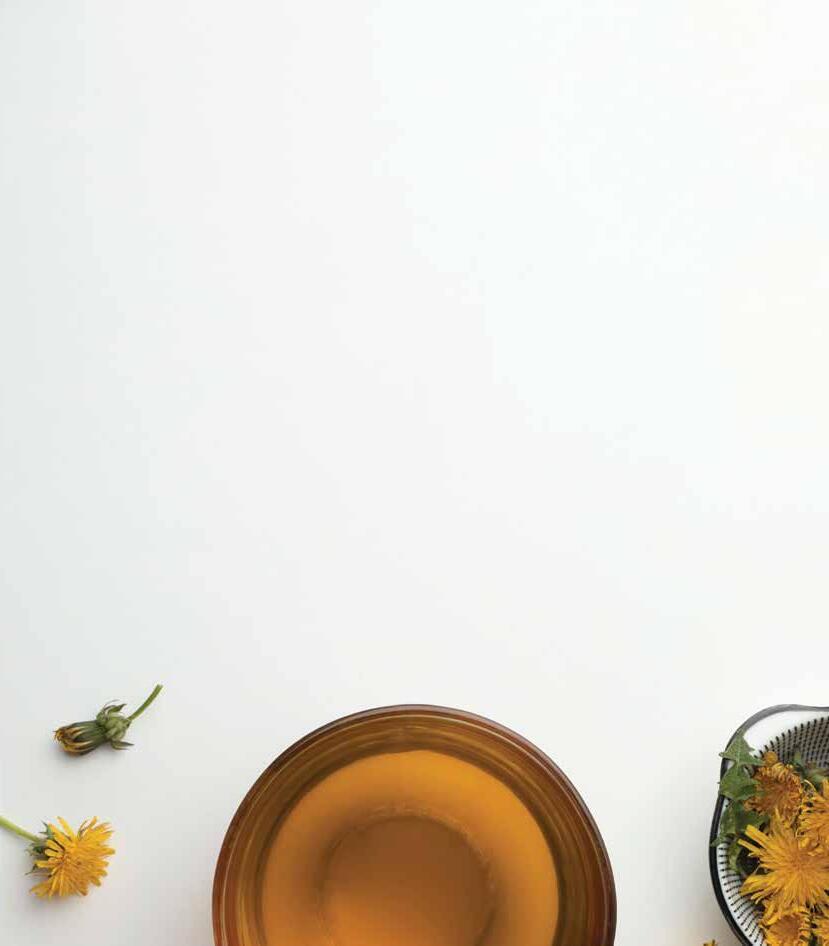
Allergic disorders such as dermatitis, hay fever, asthma, hives, anaphylaxis, along with food allergies stem from imbalances in the immune system.
Various factors, including genetics, environmental influences, inflammation, and infections, can trigger and exacerbate these conditions. Effective allergy management requires addressing multiple contributing factors.
Allergic reactions occur when mast cells release histamine. These cells are part of the immune system and normally help the body expel allergens. However, when mast cells become overactive, they release excessive histamine, leading to persistent allergy symptoms.
1. Low Histamine Diet
For individuals suffering from allergies, following a low histamine diet can help reduce symptoms. Avoid high-histamine foods and histamine-releasing foods like alcohol, cured or fermented foods, shellfish, and prepackaged meals, citrus, tomatoes, strawberries, cocoa, and bananas. However, there are many more foods to consider in managing histamine intake.
2. Identifying Food Intolerances
Think of the body as a well – when it’s nearly full, even a small addition can cause it to overflow. Similarly, reducing the allergenic load from controllable factors like food can decrease sensitivity to environmental allergens such as pollen, which are harder to avoid.
To identify food triggers, consider: Keeping a food and symptom diary.
• Getting a hair intolerance test.
• For severe allergies, consulting a naturopath who can order a food antigen panel. This blood test assesses reactions to different immune markers, including IgE, IgG, and complement.
3. Gut Health
The gut microbiota plays a crucial role in modulating the immune system. Various strains of beneficial bacteria can help balance T helper 1 (Th1) and T helper 2 (Th2) lymphocytes and normalise IgE antibody production. Histamine from food is broken down in the gut by the enzyme DAO. To support this process:
• Ensure gut lining health with supplements like zinc carnosine, slippery elm, glutamine, or herbs like licorice and turmeric.
• Maintain adequate levels of iron, vitamins B6 and B12, vitamin C, and copper, which are important cofactors for DAO production and function.
4. Immune System Modulation and Inflammation Reduction
Herbs such as turmeric, baical skullcap and albizzia can help modulate the immune system and reduce systemic inflammation. Nutrients such as vitamin c, quercetin and other bioflavonoids may help stabilise mast cells.
5. Blood Cleansing Herbs
Traditional ‘blood cleansing’ herbs like nettle, burdock, and dandelion support liver function and help remove toxins from the blood. These herbs can be easily incorporated into daily life as teas.
6. Stress Management
Stress impacts the immune system and overall well-being, exacerbating allergic reactions. Supporting your stress response is crucial in reducing the severity and frequency of allergy flare-ups. By understanding these principles and implementing dietary and lifestyle adjustments, individuals can better manage their allergic responses and improve their overall well-being. For personalised advice and comprehensive management of your symptoms, consider consulting a qualified naturopath who can guide you through tailored treatments and holistic strategies.

By Natalie Jacques Naturopath & Medical Herbalist BHSc, AdvDip Herb Med, AdvDip Naturopathy
The Herbal Dispensary 07 825 7444 | 6 Wallis Street, Raglan www.raglanherbaldispensary.nz
Nourish Taste of Tours are small group tours (max 12 pax) which give you a real taste of place.
For more details on any of these tours please email vicki@nourishmagazine.co.nz or go to nourishmagazine.co.nz
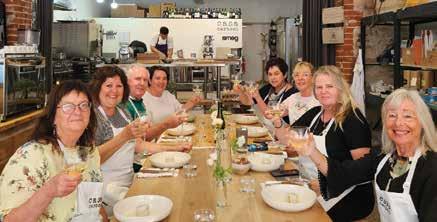
20TH-25TH NOVEMBER & 2ND-7TH APRIL
A fabulous five nights of foodie fun in South Australia with host Julia Clarke
$4500pp (twin share, incl. airfare)

14TH-25TH JUNE 2025
This tour sells out every year! Join us and discover why. We will spend 10 nights immersed in Sicily’s culture and countryside, tasting all it has to offer.
$8995pp (twin share, excl airfare)
20TH -30TH SEPTEMBER 2025
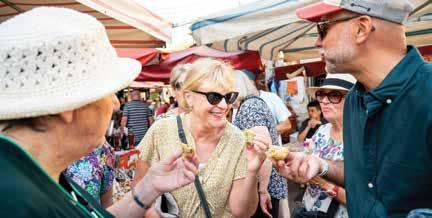
11TH -30TH SEPTEMBER 2025
Join us for the inaugural tour of Sri Lanka where we will enjoy a feast of the senses.
$6995pp (twin share, excl. airfare)

11TH -19TH SEPTEMBER
This brand-new tour will take us to the foodie heart of Italy. We will travel from Bologna through to Milan tasting lasagne, truffles, balsamic vinegar, Parmigiano, Parma ham and more.
$9995pp (twin share, excl airfare)
Our Taste of Northern Italy and Taste of Sicily tours combine for a real taste of Italy.
$17995pp (twin share, excl airfares)



We always talk about the fresh produce and artisan products at our markets but rarely touch on the readyto-eat food stalls that we have every week. These stalls are handpicked by our market team to fit into our market criteria of ‘fresh local food’. These stalls use the freshest local ingredients to produce delicious brunch, snack or treat options for your hungry tummies!
Also, spring is an exciting time for fresh avocados, asparagus, tomatoes, oranges and zucchinis. Then later in
Cornish Pasties
Susie and Lee handmake delicious traditional pasties in their bakery in Cambridge. You will find these every week at both our Cambridge and Hamilton markets. You can buy hot ready-to-eat or cold for a meal later.

Fry Bread Burgers (The Cooks Kitchen)
Tania sources local eggs and ingredients and handmakes the bread herself to create the ultimate fresh burgers. Enjoy these at both of our markets every weekend.
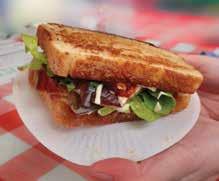

October/November berries start to ripen! I look forward to fresh blueberries, strawberries, and raspberries again.
What will you create using beautiful, local fresh ingredients? See you at our markets.
Jen
MARKET MANAGER

Lang’s Little Bakery
The Lang family create delicious gluten free, coeliac safe, low lactose or dairy free baking and attend Cambridge and Hamilton markets each weekend. Also try a freshly cooked waffle with a great selection of toppings. You won’t be disappointed!

Hoops and Scoops
This local Te Awamutu based business is founded on the idea of ‘Sharing the Joy’. That is, sharing the joy of life: the joy of family, friends, activity and community. They make their favourite treats, donuts and ice cream, in lots of varieties, using whole fresh local ingredients every day to add joy to any occasion. It’s never too cold for ice cream! Hoops & Scoops are at both markets every weekend.


Holy Crêpe!

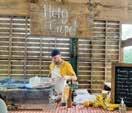
Josh proudly displays his ingredient suppliers at our Hamilton market every Sunday. You can watch him cook a crêpe for you to order so you can’t get any fresher that that! Josh enjoys a good chat too while he expertly flips the crêpe.
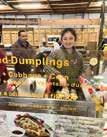
Hong Dumplings

Shan Hong handmakes all her dumplings using local fresh ingredients. There are 4 Flavors to choose from: Pork, Corn and Cabbage, Onion and Beef, Leek and Beef and Vegetable (tofu, corn, black fungus, carrots, mushroom, egg and green bean vermicelli)
Hong will cook these for you while you wait so they will be as fresh as possible. Also try her homemade chilli oil as a dip. Yum! Find Hong at Hamilton every Sunday.





WORDS & IMAGES VICKI RAVLICH-HORAN






We began our Sri Lankan adventure in the fishing town of Negombo. An hour drive from the capital, Colombo, Negombo sits on the coast, where each day thousands of fishing boats, big and small, head out to test their luck.
Their catch, and a good proportion of the fish eaten by this seafood-mad nation, ends up at the Negombo wholesale fish market. We rose early to see the action and were rewarded with just that. We stood next to the boats as men winched huge sharks, one after the other, onto the dock to be auctioned. We strolled between the vendors, our jandals wet with rain, sea water, fish blood and more, seeing sea creatures of every size and shape be brought in and sold. There are prawns not much bigger than whitebait, crabs as big as your head, stingray, tuna … the list goes on.
A pervasive smell hangs over Negombo, and it is not from the fish market, but the beaches, where endless rows of fish have been salted and then laid out in the sun to dry. As we walk along the beach watching the fish be hauled by hand in heavy baskets to be meticulously laid out on mats lining the sand we are unaware that this is the snapshot of Sri Lanka – from the dried fish we will see everywhere to the manual nature of the work, all done in the humid heat with a genuine smile.
This island south of India, believed to be inhabited since the fifth century BCE, has a rich, sometimes sad history. The Portuguese, Dutch and the English have all ruled at some point, all leaving their mark.
Independent since 1948, Sri Lanka’s most recent history has been marred by a 20 plus year civil war, a devastating tsunami and most recently an economic crisis. Yet in all the places I have travelled, Sri Lankan people would have to be the friendliest I have met.
Over the next two weeks we will travel inland from the coast, reaching the magnificent Sigiriya. We will travel south to Kandy before heading into the hills to the heart of tea country. From there we will descend down to Yala National Park before heading on to the fortified port town of Galle and then follow the coast back up to Colombo.
Along the way we pass an endless array of rice paddies. Coconut

groves turn into banana plantations and then sugar cane fields. The lush hills are terraced with tea as well as productive market gardens that eke out every square inch of croppable land. The coastline is littered with fishing boats of every size, and down south we even witness the ancient practice of pole fishing.
Add to this an abundance of wildlife, from monkeys to elephants, lizards, squirrels, water buffalo, peacocks, turtles, crocodiles, deer and leopards. Well, okay, the leopard eluded us, but we heard and saw photographic evidence they were there. It’s easy to see why this is called the Resplendent Island.
Rising dramatically from the central plains of Sri Lanka this impressive rocky outcrop rewards those who climb the 1200 steps to the top with breathtaking vistas and an insight into a very different world.
Once the epicentre of the short-lived kingdom of Kassapa (477–495 AD), who built an impressive palace on top of the rock column, accessible only through the mouth of an enormous carved lion. Frescoes decorated the walls, while elaborate plumbing brought fresh water to the top for swimming pools. You name it, if this king wanted it, the people found a way.
Today the sight is one of Sri Lanka’s key tourist destinations, but one worth the visit and the effort to get to the top. A silver lining of the crowds climbing the narrow stairs is it’s a slow climb up and thus doable for many.
A sacred pilgrimage site for 22 centuries, the Dambulla Cave Temple was a great introduction to Buddhism. With five caves containing 150 Buddha statues, it is the largest, best-preserved cave-temple complex in Sri Lanka.
We had made it to the summit of Sigiriya the day before, so the 160m climb up hill to reach the caves felt like déjà vu and had me believing Buddhists are very fit!

Sri Lanka is teeming with wildlife, and this was one of the reasons we wanted to visit. Of its 28 national parks, Yala is the largest and one of the oldest. Bordering the Indian Ocean its 130,000 hectares includes mangroves, lagoons, light forest and grassland and is home to over 200 different types of birds and 44 mammals, not to mention a crocodile or two. Rising before the sun, we joined the line of jeeps waiting to explore the park. Peacocks, water buffalo, deer and a number of different birds kept us thrilled for over an hour. Rounding a corner, we saw a group of jeeps stopped at a watering hole. As we got closer, we could see what they saw – a mama elephant and her month-old calf. After that I would have been content to go home. Seeing such a majestic animal and her baby in the wild was a pinch me moment.

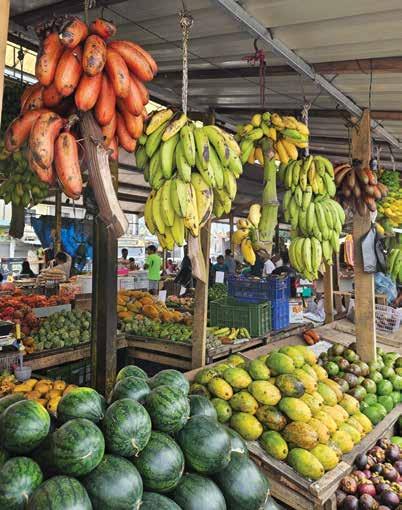
As we passed Udawalawe National Park our excitement of seeing the elephants in the wild was tempered with reality. We were


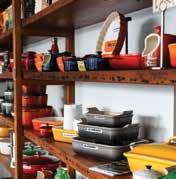



heading to the Udawalawe Elephant Orphanage but along the way we saw lone elephants hanging around by the park’s perimeter wire. Instead of roaming the forest and foraging, they were waiting for tourists to stop for a photo and feed them.
The fact is elephants and humans don’t mix well. It’s estimated one elephant a day is killed by humans in Sri Lanka. And at the same time Sri Lanka has the most deaths of humans by elephants in the world. Elephants roam freely across half of Sri Lanka but 70% of this land is shared with humans and the result is conflict.
The Udawalawe Orphanage cares for and rehabilitates orphaned elephants, preparing them to eventually be released back into the wild. Visitors can learn more about elephants and their plight while also enjoying the very cute feeding time.
With the abundance of spices grown in the south, Galle had long been part of the ancient Maritime Silk Road. The fort was built by the Portuguese when they arrived and then extensively fortified by the Dutch when they took over. By the 1800s maritime shipping had evolved and Galle Fort became out of date – too small to house larger ships, and too treacherous compared to newly established, modern ports in Colombo.
The lack of economic development meant instead of being redeveloped the fort was left to fall into disrepair. Then when the 2004 Boxing Day tsunami devastated much of the South Coast of Sri Lanka, claiming 35,000 Sri Lankan lives, the fort’s walls saved much of the old town.
Now a UNESCO World Heritage site, the many old buildings have been restored and there is a sense of calm, with its charming streets and faded European architecture. We walked around the walls, taking in the famous lighthouse, the crazy free divers and snake charmers.
Venture inside and enjoy getting lost in the winding streets, partaking in some shopping or stopping for a cocktail or two with the local spirit arrack.
There are two things you have to do when in Colombo. One is visiting Galle Face Green at sunset. Here you will join local families, school groups and tourists flying kites, strolling around

the park, eating street food and enjoying the sunset.
The second thing is to take a tuk-tuk tour around the back streets and markets. Here our guide walked us through Sivan Kovil Hindu temple, explaining how this temple, carved from granite, was made, while giving us an insight into the Hindu religion. We then headed into what would have been the old bazaar to discover rice, spice and coffee traders. After weaving between traffic, we stopped at an inconspicuous building and headed down a narrow hallway before climbing several flights up a fire escape to find ourselves above the chaos. Here, with a cold beer in hand, was the perfect place to reflect on the amazing journey we’d had through Sri Lanka.
FoodRice & Curry – Signs for rice and curry are everywhere in Sri Lanka. This staple meal consists of first and foremost rice, served with an array of dishes ubiquitously described as curry. This oversimplification describes many delicious dishes from dahls to sambals to fish, vegetable and meat curry.
Gotu Kola Sambal – This green salad made with fresh coconut and lime is the perfect accompaniment to the rich and often spicy curries. Gotu kola, the green leaf used, is Indian pennywort, but kale or even rocket would be a good substitute in New Zealand.
Kottu Rotti – Resourcefulness often creates epic dishes and kottu rotti is a great example of this. Left over roti is thinly sliced and stir fried with vegetables and spices to create a dish that can be found everywhere from street vendors to high end restaurants.
Hoppers – These light, lace-like rice flour crêpes were a favourite breakfast option for me. They can be served in a variety of ways, plain with a selection of sambals or spicy relishes or, my preference, with an egg.
Curds and Treacle – As we drove south from Yala, the streets were lined with stalls selling mee kiri, or buffalo curd. Sold in their unique terracotta dishes, the curd, popular at breakfast time, is served with a sweet treacle (kithul peni) which is made from the sap of the kithul palm and is delicious!
Bananas – There are so many bananas in Sri Lanka I seriously doubt the statistic that Kiwis eat the most bananas per capita in
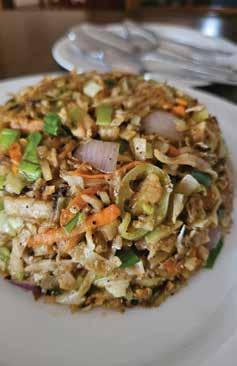

the world. Forget the tasteless large Cavendish bananas we are used to, instead the bananas in Sri Lanka come in an array of shapes, sizes and colours, not to mention tastes.
Jackfruit – For centuries, this humble fruit has been revered by Sri Lankans, as it repeatedly saved the island from starvation. Jackfruit trees are protected in Sri Lanka, for this very reason. The tallest fruit trees in the world can produce fruit weighing over 50kgs.
Both the ripe and unripe jackfruit are used throughout Sri Lanka. The unripe fruit is used to make a filling curry while the mature fruit is used as a substitute for rice.
Taste of Sri Lanka Tour 2025
Join me for a wonderful 10 days getting a real taste of Sri Lanka, but get in quick as we only have six spaces left!
14th-25th June 2025
Cost $6995pp (twin share)
email vicki@nourishmagazine.co.nz for more details.

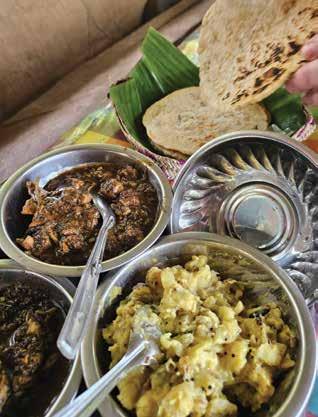
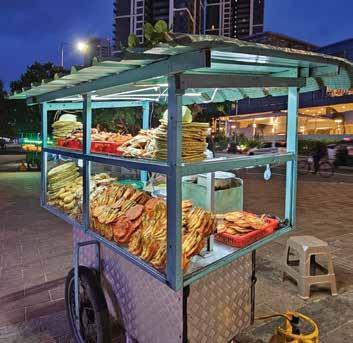
Over 42 years of bespoke design, craftmanship and repairs of precious jewellery.
307 Barton Street, Casabella Lane, Hamilton P. 078390039 www.midasdiamondjewellers.co.nz


Jennifer Duval-Smith, the botanical artist behind the fennel watercolour illustration gracing our spring cover, was delighted to work with Nourish again.
Previously, Jennifer had been approached by editor Vicki RavlichHoran to design Nourish: The Cookbook 2 which went on to win an international award for cover design. Although outside her realm of botanicals, the two came up with the idea of wooden cooking spoons.
“They have that lovely wood grain aspect too,” says Jennifer. “I felt that the cookbook itself had some very treasured recipes in it
and would be the kind of cookbook to become food splattered with time and overuse.”
So began Jennifer’s quest to find spoons from some of the best cooks in her acquaintance. She was drawn to spoons that have had a good long life rather than a tough life. Included are her mum's jam spoon, and one from Lynda Hallinan who photographed her favourite spoon and told Jennifer to ignore the dog hair!
“It was a funny exercise because people are emotionally attached to their favourite spoon and remember where or how they got it. They all have particular purposes and it did feel like a lovely story. And soon the spoons felt like sisters all lining up there.”
Jennifer’s trajectory of becoming an artist was not straightforward,
although her grandmother was a landscape watercolourist and her own mother is obsessed with colour and clouds. “I came late to my profession, and I hope that my story shows that anybody can find and embrace their own creativity.”
Jennifer trained in law, which morphed into marketing, events and public relations, roles which all demand attention to detail, engaging with people and creative problem solving. These qualities are ones she finds very useful as an artist and nature journalling educator today. However, a very demanding corporate life in tandem with raising three lively boys had her questioning whether she was living according to her true values of nature, creativity and connection.
“In my family we were always encouraged to notice and name small and subtle details in nature. In working out where I needed to be, I noticed that quietly observing and recording was where I felt most like myself. My first school report said, ‘Jennifer looks for subtle complications,’ and I think it has always been true.”
In 2013 the sale of their PR business meant that she could focus on her creativity and living and working in a way that felt more authentic. During a family campervan trip around the South Island she began to experiment with watercolour sketches of natural subjects and a major step forward was the 100 Day project challenge. She credits this initiative, whereby participants create a small painting over this time period, as helping her to break through some preconceived notions. “For any would-be creative, the accountability structure of the 100 Day project forces you to get over yourself and produce something whether good, bad or indifferent. It also helped me over the barrier of allowing my work to be seen by the public.”
Jennifer decided to see what would happen if she were to experiment with painting, which she had been doing in a private capacity. In 2018 she answered the call by Auckland Botanical Gardens to submit a painting of a native New Zealand plan for the Botanical Art Worldwide exhibition. Entering her painting of rewarewa ‘Seven Sisters’ also connected her to a group of supportive artists working in the realm of the natural world.
Jennifer successfully applied for the artist in residence position at the Auckland Botanic Gardens, focusing on her first love, which is edible plants. During this residency Jennifer’s mindset shifted. “I began to think of myself more as an artist as opposed to somebody who paints.”
While working towards her exhibition she was available for people to look and talk to during the week and to run workshops
which, with her background in marketing, was familiar territory, but she was surprised at how much she enjoyed her role as an educator. She worked out that by pairing people together, such as carers with children, by focusing on the nature journalling element that this was an accessible and lovely way to learn.
As Jennifer’s own art practice has developed, she is aware of not being too prescriptive, acknowledging that many people have grown up with the idea of perfectionism, particularly women. “I've definitely come down that line and I broke away from it, so my idea is that there are many ways to do things. Some of those ways are good enough. You do not make yourself safe by sticking to the rules.”
She has taken this lesson and imported it to her life and finds the freedom that it has created has seen her learn and explore more and ultimately be more pleased with the results. “Everybody has their own individual artistic voice. They just need to be encouraged to express it. Seeing people take this step and find their joy in the process, rather than being critical of the result, is the ultimate inspiration for me. Moments of insight and a shared sense of wonder – these are the reasons I do this work.”
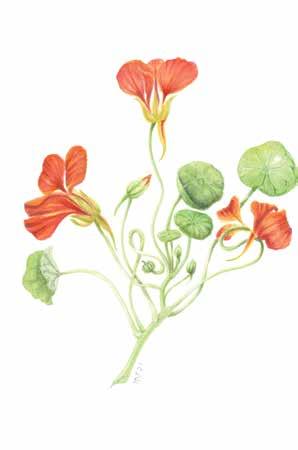
Jennifer runs workshops for anyone who is interested in exploring botanical art and nature journalling. Sign up for her newsletter at jenniferduval-smith.com
Take a moment to reconnect with nature, food and your own creativity!
Nature journalling workshop and lunch in the organic vegetable garden at The Falls Retreat Sunday 22 September 2024, The Falls Retreat, Waihi. Book at www.fallsretreat.co.nz


WORDS RACHEL HART
Have you ever cooked with fennel? Sure, it has an unusual appearance and surprising liquorice scent, but I urge you not to judge this book by its cover! Fennel is a vegetable with a rich history, an impressive nutrient profile, and versatile culinary uses that have been embraced around the globe for centuries. From its distinctive seeds to its crisp bulb and frilly leaves, fennel deserves a prominent place in your kitchen this spring.
Originally from the Mediterranean, fennel’s first home is thought to be either Italy or Greece. In ancient Italy, Roman warriors ate fennel to stay healthy and strong, and they believed fennel tea brought them courage before battle. In today’s Italy, you might find fennel in a gratin, in pastas like spaghetti con finocchio, and in salads tossed with olive oil, lemon, and salt.
Fennel has become popular in the Middle East where the bulb – the crunchy white base – is often roasted and paired with aromatic spices like sumac, saffron, or za’atar, enhancing its natural sweetness with tangy, earthy notes.
While some nations prefer to cook with the bulbs, others shine a spotlight on the feathery fronds found at the top of fennel. In seafood-heavy Scandinavian cuisine, fennel fronds are often used as a garnish, while Provençal cooks in southeastern France use them to top soups like bouillabaisse. In Greece, the leaves find their way into a traditional fennel pie called marathopita.
Beyond the bulbs and the fronds are fennel seeds, and while they may look like cumin, the smell couldn’t be

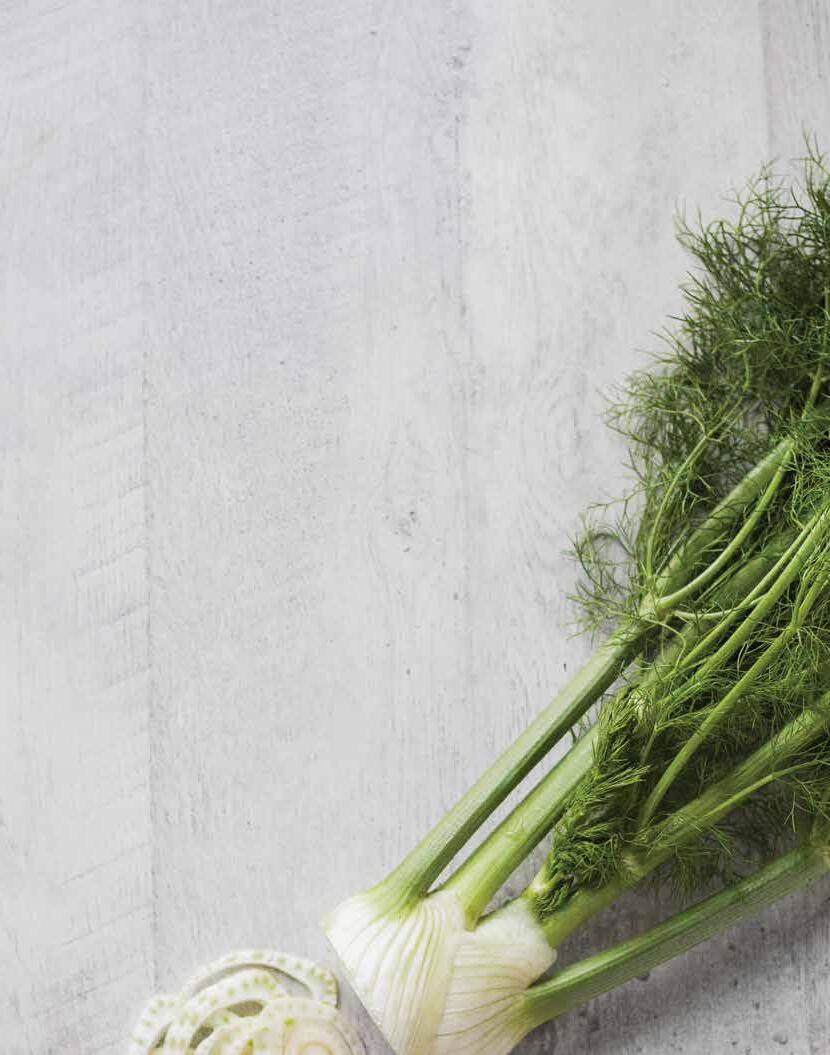
more distinct. To tell the difference, just take a sniff: if you’re met with the spicy-sweet scent of liquorice, it’s fennel.
India is the world’s largest producer of fennel, and much of that is for the fragrant seeds. Fennel seeds are commonly used in pickles, chutneys, and spice mixes (masala), but they are also a much-loved way to end a meal. Serving colourful, sugar-coated fennel seeds after a meal is a centuries-old tradition: the seeds soothe the stomach and aid in digestion, while the liquorice flavour freshens your breath, and the sweet coating signals the end of a meal.
Fennel is not only incredibly versatile, but also exceptionally rich in nutrients. It has trace levels of many vitamins and minerals, and is notably high in vitamin C, vitamin K, and potassium, making it a healthy choice for boosting immune function and maintaining healthy blood pressure levels. It is filled with phytonutrients, which are antioxidants that help the body ward off inflammation.
While nutrients and antioxidants are typical of vegetables, fennel offers a couple of more unexpected health benefits. Its natural calming effect is so powerful that many insomnia sufferers turn to fennel tea as a natural sleep aid. And fennel seeds are so good at boosting milk production that new mums would be hard-pressed to find a lactation cookie that doesn’t include fennel in its ingredients list.
Whether you’re eager to explore its unique flavour or harness its health potential, now is the time to become a fan of fennel.
Rachel Hart
Hailing from Canada, Rachel has fallen in love with life in the beautiful Bay of Plenty where she is a freelance writer with a passion for healthy food. She splits her time between telling people’s stories, creating web content and experimenting in the kitchen.

Fennel bulbs’ aniseed flavour and crisp texture is something I look forward to every spring in my garden, and thankfully they’re also easily found at supermarkets and farmer’s markets throughout spring if you don’t have a garden.
My favourite way to eat fennel will always be raw, finely shaved in salads where its crispness is key, but should you find yourself with an abundance of fennel bulbs, using them as the base for soups is also a lovely way to consume.
The classic pairing of finely shaved fennel bulb with orange is not one that will ever go out of fashion! Here I’ve boosted the flavour further with an Aleppo pepper flecked dressing. You’ll find Aleppo pepper at selected specialty food stores (like Vetro). It has a lovely mellow heat and beautiful colour and flavour, but of course use regular chilli flakes if that’s what you have on hand.
SERVES 4
1 medium fennel bulb
juice ½ lemon
1 x 200g packet halloumi, sliced thickly
2 oranges, peeled (remove white pith too) and thinly sliced
½ cup black olives, pitted and roughly chopped (I used Kalamata)
½ red onion, finely sliced
large handful flat parsley leaves, roughly torn
small handful fresh mint leaves, finely chopped
½ tsp Dijon mustard
½ tsp honey
½ tsp Aleppo pepper flakes (or a pinch of regular chilli flakes)
juice 1 lemon
3 tbsp extra virgin olive oil
fine sea salt and freshly ground black pepper
Fennel really mellows when cooked, so I amp up the flavour again with toasted fennel seed flavoured lentils to top the soup with. If you can’t be bothered with the lentils (in their defence they add a nice boost of protein to the soup!), make a flavoured oil with the fennel seeds, chilli and lemon zest to spoon over the soup instead.
SERVES 4
3 tbsp olive oil
1 medium leek, washed well and finely sliced
4 cloves garlic, roughly chopped
2 large fennel bulbs, sliced (reserve tops to serve)
2 medium potatoes, peeled and diced
4 cups water or vegetable stock
3–4 tbsp sour cream or crème fraîche
¼ cup black or puy lentils
(available at La Cave or Vetro), rinsed and drained
1 bay leaf, fresh or dried
3 tbsp olive oil
½ tsp Aleppo pepper flakes or a pinch of regular chilli flakes
¼ tsp fennel seeds, lightly toasted and roughly ground
finely grated zest 1 lemon
fine sea salt and freshly ground black pepper
Finely shave the fennel bulb using a mandolin or a super sharp knife. Transfer to a bowl, squeeze over the ½ lemon and mix well. Meanwhile heat a large heavy-based frying pan over high heat and cook the halloumi, turning to brown on both sides. Remove from the pan and cut into bite-sized pieces.
Combine Dijon mustard, honey, Aleppo pepper and lemon juice in a small bowl and whisk to combine. Continue whisking as you drizzle in the olive oil. Season with salt and pepper.
In a large serving bowl, layer shaved fennel with pieces of halloumi, orange slices, black olives, red onion and herbs. Drizzle over dressing and serve immediately.
Heat olive oil in a large saucepan over medium-high heat. Add leek, garlic and fennel and cook, stirring occasionally for 5 minutes or until tender. Add potato and water/stock, season lightly with salt and bring to the boil. Reduce heat and simmer with the lid partially on for 20 minutes, or until everything is cooked through.
Meanwhile, place lentils into a small saucepan with the bay leaf and cover with plenty of cold water. Bring to the boil, reduce heat to a simmer and cook 15–20 minutes or until tender. Drain through a fine sieve and set aside 5 minutes still in the sieve to ensure as much excess liquid has drained as possible.
When soup is cooked, remove from the heat, add sour cream and blend with a stick blender until smooth. Alternatively, for a super smooth soup you can transfer to an upright blender and pulse until smooth. Set aside with the lid on to keep warm.
To make the frizzled lentils, heat olive oil in a small saucepan, add Aleppo pepper, fennel seeds and lemon zest and cook briefly until fragrant. Add drained lentils and cook, stirring often 5–8 minutes or until warmed through and some lentils are starting to crisp up a little. Season with salt and pepper and spoon over hot soup to serve, with a little reserved fennel tops and extra pepper flakes, if you like.
To speed things up, pre-cook the lentils up to 2 days before needed and store in a lidded container in the fridge. Any leftover soup can be stored separately in the fridge for up to 3 days. Reheat to serve.
theshackraglan.com Bow St, Whaingaroa, Raglan
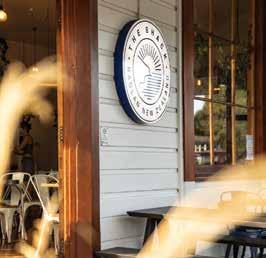


Emma Galloway mydarlinglemonthyme.com @mydarlinglemonthyme @tahu.ceramics
Best-selling author of three cookbooks and award-winning blogger, Emma Galloway is also a chef, photographer and budding potter. After years of living overseas, she has settled back in her hometown of Raglan, where she is inspired by the seasons and her extensive veggie garden.

CrushGrind® mills are much more than traditional salt and pepper mills. Based on the principles of the old mortar, CrushGrind® was developed to be more than just a pepper mill. Designed to crush and grind whole spices, releasing their full aromas and flavours, elevating and stimulating our senses.
Plus, they look gorgeous, coming in a range of colours.
Available instore and online: readbros.co.nz
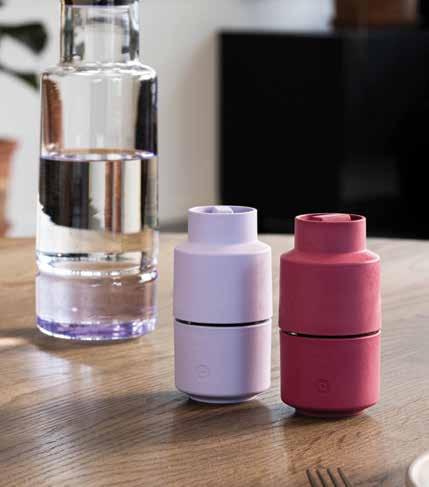
With its ability to carbonate any beverage, including water, juices, wine, and even cocktails, OmniFizz offers endless possibilities for creating custom fizzy beverages. This innovative product is perfect for those who love experimenting with flavours and want to add a touch of sparkle to their daily drinks. Plus, you can say goodbye to single-use plastic bottles when satisfying your need for a fizzy drink.
Available online at drinkmate-aus.com.au
Two lucky Nourish VIPs will win a Drinkmate OmniFizz this spring. Not a VIP? Go to nourishmagazine/subscribe and for just $49 a year we’ll send you a fresh copy of Nourish every season. Plus you go in the draw for great prizes like this.
'Fold Flat Easy Juicer' = Fluicer. An easy squeeze citrus juicer that folds completely flat for space-saving storage. It’s citrus season and all those lemons won’t squeeze themselves. Pick from a variety of sizes at The Flower Crate and get juicing!
The Flower Crate, 1/394 Grey Street, Hamilton East theflowercrate.co.nz
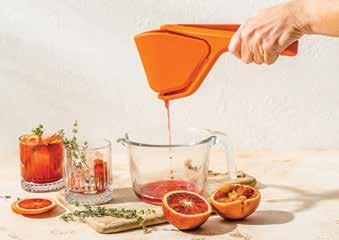
Porcelain benchtops, available in a range of colours and finishes, are the hot ticket in kitchens right now. Suited perfectly for the on trend thinner bench profiles, they can also be mitred to create the effect of thicker benchtops or shelves. Hayley from Treetown Kitchens says, “Not only do porcelain benchtops look amazing, they are also user friendly. Porcelain is resistant to thermal stress, meaning your hot pots can be sat straight on the benchtop, and given its non-porous nature, porcelain benchtops will not absorb stains like other natural and engineered stones would.”
www.treetownkitchens.co.nz

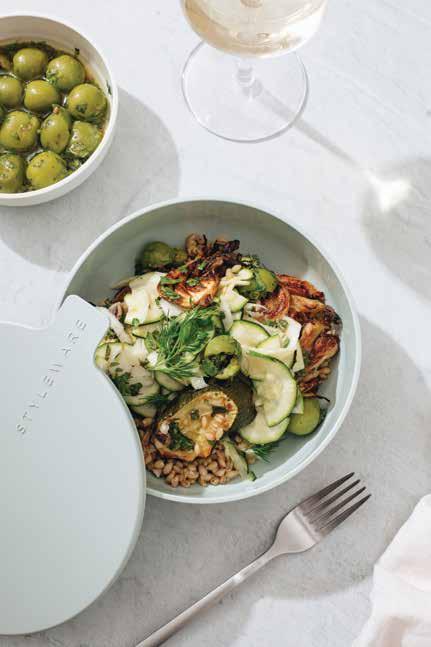

In Italy, where the kitchen is the heart of the home and where coffee is a passion that brings friends and family together, Bialetti is found in nine out of ten households.
Inventors of the legendary stovetop espresso maker, Bialetti has truly earned its iconic status with coffee lovers and design aficionados. The Bialetti Dolce&Gabbana collab range sees two iconic symbols of Italian style and design unite. Get yours at Vetro Hamilton, 122 Rostrevor Street.
all!
Created by Perth couple Arabella and Matthew Selby, who say they wanted to design the bowl that did it all. Good enough to take to a friend’s for a swanky little dinner party but be functional enough (aka light and snap tight) to carry to work every day. It had to be long-lasting and not create more waste. And just as importantly, it had to look good.
Reusable, stackable, microwave and dishwasher safe and unabashedly gorgeous, Styleware Nesting Bowls are available at The Sunday Society, 452 Tauwhare Road, Matangi. www.thesundaysociety.co.nz
There are almost always home-made biscuits in my house. I love a treat with my cuppa before bed and find home baking is more satisfying than those from a packet.
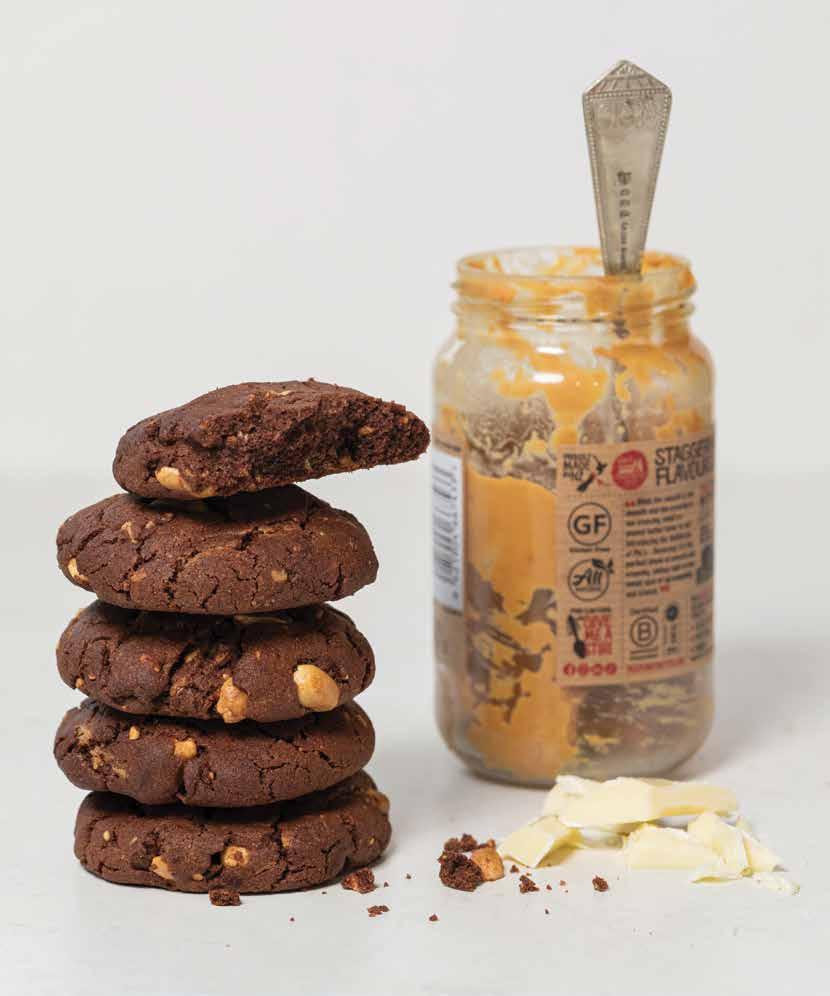
These work well with dark chocolate chips instead of the white chocolate, although they can’t then claim to be double chocolate cookies, which is what I also told my sister when she said they didn’t even need the chocolate. Feel free to omit and change the name!
MAKES 12–18
75g butter, softened
½ cup sugar
½ cup brown sugar
1 cup peanut butter
1 egg
½ cup cocoa
1 cup self-raising flour
½ cup roasted peanuts
125 g white chocolate, chopped
Cream the butter and sugars together until light and fluffy. Beat in the peanut butter and egg.
Add the cocoa and flour, and mix. Then stir in the peanuts and white chocolate.
Roll tablespoonfuls of dough into balls and place on a lined baking tray, 2–3cms apart.
Bake at180°C for 15–18 minutes.



I often purport that you can easily make an average biscuit great with the addition of chocolate. These, though, prove that not all biscuits require chocolate to be delicious. Soak the raisins in your favourite black tea. Earl Grey or a chai blend, although neither my favourite drinking teas, work perfectly in these.
And while tea adds to the flavour, it’s also the perfect accompaniment too.
MAKES 12–15
½ cup strong tea
1 cup raisins
125g butter, softened
¾ cup sugar
1 tbsp golden syrup
1 tsp baking soda
1½ cups flour
Soak the raisins in the tea for at least half an hour.
In a medium size pot melt the butter, sugar and golden syrup together. Add the baking soda and stir so that the mixture foams.
Drain the raisins and add to the butter and sugar along with the flour.
Place tablespoonfuls onto a lined baking tray and bake at 180°C for 10–15 minutes, or until golden brown.
You can never go wrong with a chocolate chip cookie. I love these ones as they satisfy my sweet tooth and need for a treat with my nightly cuppa while also fooling me in to thinking they are wholesome with the oats. Cranberries balance them out with a little tartness, but dried apricots will work too!
125g butter, softened
½ cup brown sugar
½ cup sugar
1 egg
1 tsp vanilla extract
1 cup flour
1 tsp baking powder
1 cup rolled oats
½ cup cranberries
125g dark chocolate chips (I use the xx from Vetro)
Cream the butter and sugars together until light and fluffy.
Beat in the egg and vanilla.
Add the flour, baking powder and rolled oats and mix these in with a wooden spoon. Finally, mix in the cranberries and chocolate.
Roll tablespoonfuls of dough into balls and place on a lined baking tray, 2–3cms apart.
Bake at 180°C for 10–15 minutes, or until golden brown.
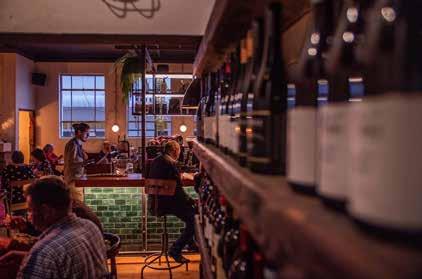
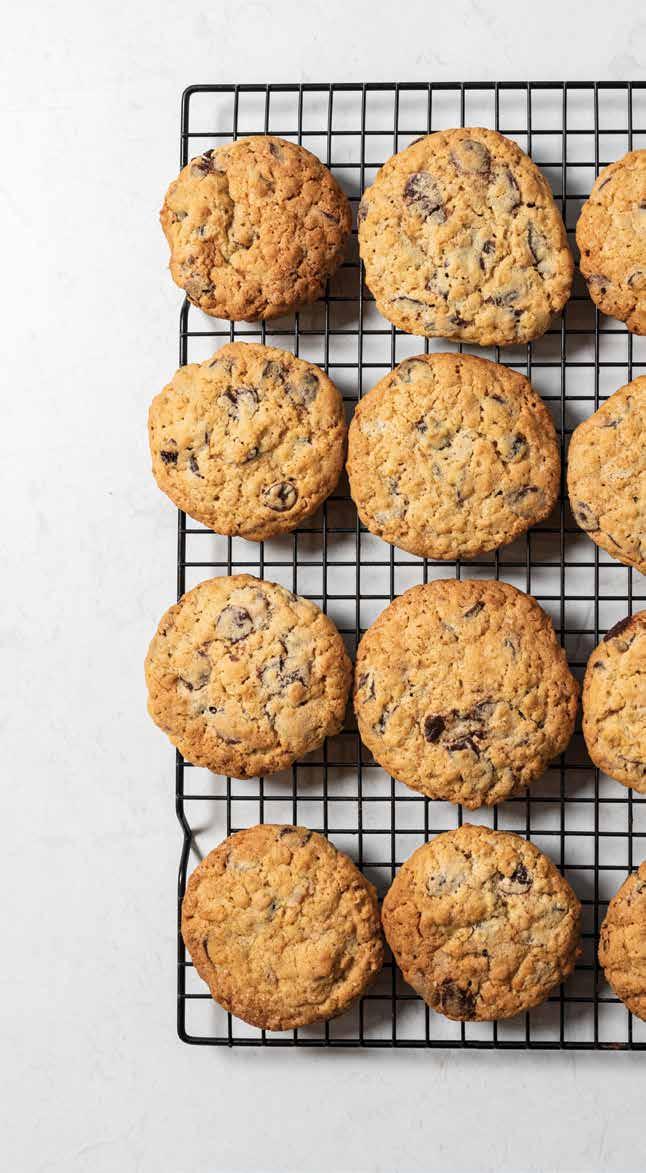

The process of making cheese is an ancient artform and is thought to have happened by accident in the Middle East when a shepherd carried milk in a bag made from a sheep stomach. Despite the dizzying array of cheeses now made, the method remains simple: bacteria or acid (lactic acid in the case of our shepherd) is added to milk to curdle it. From this the curds and whey are separated; the curd being turned into the countless versions of cheese enjoyed around the world.
What creates these variations begins with the milk, be it cow, goat or sheep. Add to this what the animal has grazed on and how the milk is treated, be it pasteurised or not.
Ageing is a key factor for some cheeses, while the introduction of different bacteria or flavours is for others.
Being a proud dairying nation it is not unexpected that New Zealand would be able to produce some world-class cheeses. Kapiti’s Kikorangi Creamy Blue, a regular winner at the New Zealand Cheesemakers Awards, recently won the Supreme Award for an International Cheese at the International Cheese Awards. Kikorangi Creamy Blue has also done what many of our local cheeses need to do. This Gorgonzola-style cheese is not a Gorgonzola but would be the go-to creamy blue cheese for most New Zealanders. Made in Taranaki, it is a New Zealand cheese through and through, including its name.
New Zealand’s recent signing of a free trade agreement with the EU has meant what we name our cheeses is very important. Within seven years we can no longer name cheeses Gorgonzola or feta.
Simon Lamb, President of the New Zealand Specialist Cheesemakers Association (NZSCA), says seven years is not long for this monumental change. “Even at a government level they don’t understand the enormity of this issue.” And while feta and Gorgonzola are the two cheeses affected currently, the agreement allows for more cheeses to follow suit.
And if we think we are going to solve the problem by adding an extra to ‘t’ to feta or making it Kiwi with a name like Weta, Simon says think again. The EU rules mean the cheeses outside their PDO (protected designation of origin) cannot have any connection to the original name.
Simon also points out “that the reach is beyond just cheesemakers”, with food manufacturers and eateries unable to use the names feta or Gorgonzola as an ingredient unless it’s the real thing. For instance, that feta and spinach filo at the local cafe will soon no longer be described as such unless that feta came from Greece.
The NZSCA are creating a steering group to help New Zealand producers navigate these changes. Simon believes there have been lessons learnt from the wine industry, which went through similar changes when they could no longer use the name Champagne. In fact, when these changes came into play, New Zealand saw a drop in Champagne sales as Kiwi’s rallied around our Methode Traditionnelle wine makers. “To be brutally honest, that’s what we need to see happen again,” says Simon.
While New Zealand has seen an explosion in specialty local
cheeses over the past two decades, this market is threatened by cheap imported cheeses. “Ten years ago,” Simon explains, “whey was a by-product of cheese. Now cheese is the by-product of whey.” This means there are international companies with cheese they are happy to sell cheaply to get it off their hands.
As with everything in life there needs to be a balance. I spoke to Anna from Vetro, which stock a range of both New Zealand and quality imported European cheeses, to find out more.
For the blue cheese fans, Vetro stock, among other blue cheese for you to try, picante and dolce protected destination of origin (PDO) Gorgonzolas. The picante, Anna says, “boasts a strong tangy flavour and is characterised by its sharp blue veins. Dolce meaning ‘sweet’, offers a milder and creamier profile and this younger version is recognised for its soft and buttery texture.” Both are a cow milk cheese aged for a minimum 50 days.
“The other very popular blue we stock is the French St Agur with lots of blue veins but a mild creamy flavour. The New Zealand Whitestone Windsor blue is also outstanding with a very buttery texture and not too intense.”
Anna believes “our customers must be very discerning”, as Parmigiano-Reggiano is their top selling cheese. While parmesan is the generic name for this style of cheese, the real deal is Parmigiano-Reggiano PDO, produced in the Italian provinces of Parma and Reggio Emilia. (Join me on our Taste of Northern Italy tour in 2025 to see Parmigiano-Reggiano being made and aged.)
Join the Vetro Hamilton team celebrating their 4th birthday on the 14th of September as they crack open a 54-monthold wheel of ParmigianoReggiano!
The governing body behind the PDO stamp, the Parmigiano Reggiano Consortium, requires all of its cheeses to be produced by hand and to use milk from cows following a specific diet. The cheese then must be aged for at least 12 months. After 12 months, every wheel of cheese is inspected by the Consortium, at which point, if approved, the wheel officially earns its ParmigianoReggiano approval.
Aged further, and the character will continue to change. Anna says, “As the cheese reaches 36 months or older, notes of spices become more prominent in both the aroma and flavour. It is highly digestible and rich in nutrients, suitable for lactose intolerant and younger children. Over 40 months, the flavour of ParmigianoReggiano becomes particularly bold and intense, with a strong grainy texture. It has a very intense aroma with fragrances of spices and smokiness, which make it an ingredient with a bold flavour or the real star of the show for aperitifs. If you happen to find a 50-month Parmigiano-Reggiano, you can trust you're in for an intensely crystalised treat.”
Brie de Meaux is considered one of the ‘Kings of Cheeses’ and one of the most known French Bries. Another protected cheese, this one is made from raw milk from Meaux, just outside of Paris. French range of fromagier cheeses. These double-cream soft cow’s milk cheeses, similar to Brie, have gone through an
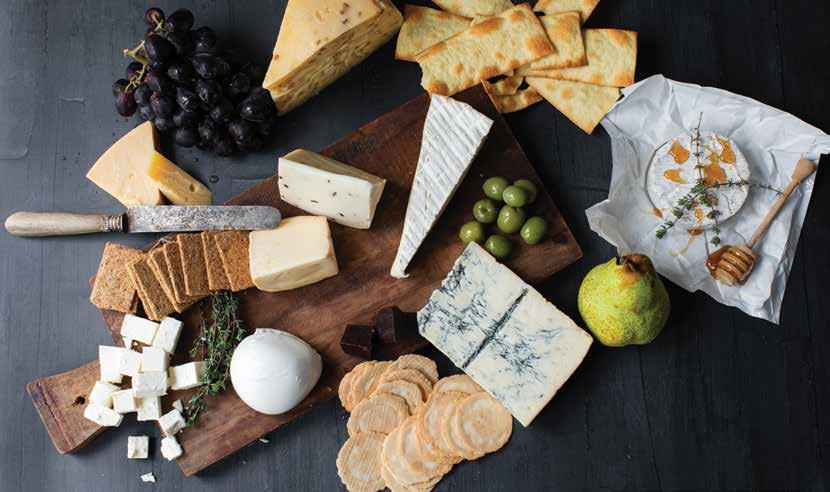
ultrafiltration process, removing water from the pasteurised milk making them creamier, with more nutrients and proteins than a Brie. Anna recommends eating these at room temperature, “so it oozes with flavour and creaminess.” There are a range of flavours including a blue, truffle and brand-new garlic and herbs.
Sheep and goats cheeses. “We are noticing that more people are becoming more lactose intolerant,” says Anna, who points out that their wide range of sheep and goat's milk cheese seems to be more digestible for some people. “Whilst sheep and goat's milk are not free of lactose, they have much less amounts and seem to be more tolerated by people.”
“Most of our Greek cheeses are made from sheep and goat's milk. Our Italian pecorino (the ONLY cheese to be used in an authentic carbonara), is a great option for those with cow’s milk intolerances. Derived from the word ‘pecora’ (which means sheep in Italian), pecorino is an Italian hard cheese produced from sheep’s milk. Our beautifully mild Italian sheep cheese, brigante, is a young cheese made from whole sheep milk. The fresh and savoury taste of this young cheese goes beautifully with the intense flavour of truffle.”
Another standout for Anna is their Spanish Manchego. “These are a dry sheep milk cheese and well worth trying. They don’t have a strong sheep flavour, but a very umami flavour comes through.”
Sitting proudly among the imported cheeses at Vetro are some of our outstanding New Zealand cheeses, including Whitestone.
“We love our New Zealand Whitestone Bries,” says Anna, “being a well-priced, reliable cheese. It is not every day we can afford our lovely imports and the Whitestone Bries do a great job for that everyday version. The Whitestone Windsor Blue is also outstanding with a very buttery texture and not too intense – my go-to blue. Their Havarti style cheese in a bright orange wax rind looks (and tastes) fabulous on any cheese board, as does the tasty Roundhill with its deep blue wax rind.”
The Zany Zeus range, including their ‘feta’, halloumi and this food writer’s favourite ricotta, are must trys! “Once you’ve had a Zany Zeus Greek yoghurt, you’ll find it difficult to buy another brand,” says Anna. “I add the Zany Zeus Mint ‘Feta’ to most of my dishes requiring feta and the result is invariably amazing!”
While some cheeses rely on ageing, others are best fresh, and this is the case for mozzarella, so you can’t beat the Clevedon Buffalo range.
While these cheeses aren’t new, many have been hard to find in New Zealand.
Raclette is an incredible melting cheese, specifically made for melting and pouring over other foods like tartiflette, which is a delicious dish with the cheese melted over potato, bacon and onion. “Don’t be fooled by the stink,” warns Anna, as with many French cheeses “the taste is outstanding”.
Comté, one of France’s most popular cheeses, is made from unpasteurised cow's milk in the Franche-Comté region of eastern France bordering Switzerland. Nutty and sweet in flavour with notes of toffee and hazelnut, Comté is similar to Gruyère, used for melting in sauces or is simply eaten for breakfast with jam and bread.
Kefalotyri is a hard, salty white cheese made from sheep milk or goat's milk in Greece and Cyprus. If you love halloumi give kefalotyri a try.
Italian provolone, Anna says, “are amazingly versatile cheeses which work well on your cheese board, in a sauce or on a pizza with their perfect melting point making them a must-have in anything cheesy.”
Vetro Hamilton
122 Rostrevor Street, Hamilton vetro.co.nz
WORDS VICKI RAVLICH-HORAN | IMAGES BRYDIE THOMPSON
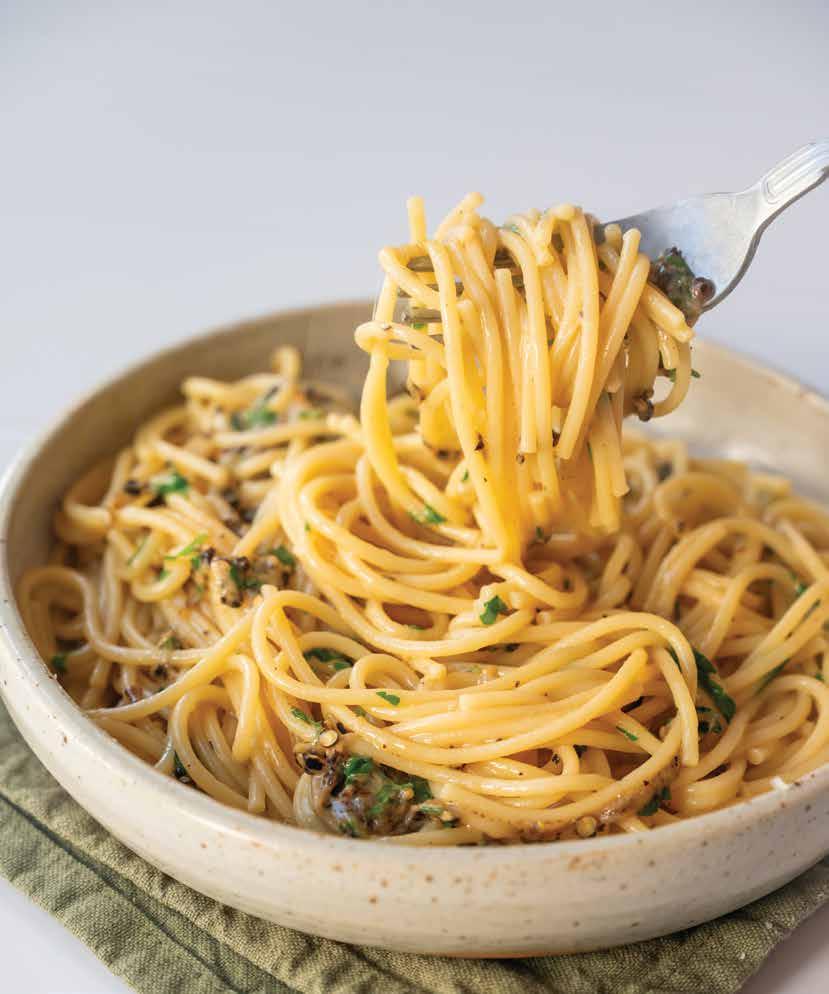
Cacio e Pepe or ‘cheese and pepper’ is a classic Roman pasta dish that dates back centuries. The key to this dish is its simplicity – three ingredients transform into a moreishly addictive pasta. The delicious cheese and pepper combo is one you can enjoy with gnocchi, in a quiche or with scrambled eggs or, as I prove below, on pizza, in gorgeous puffs and sausage rolls.
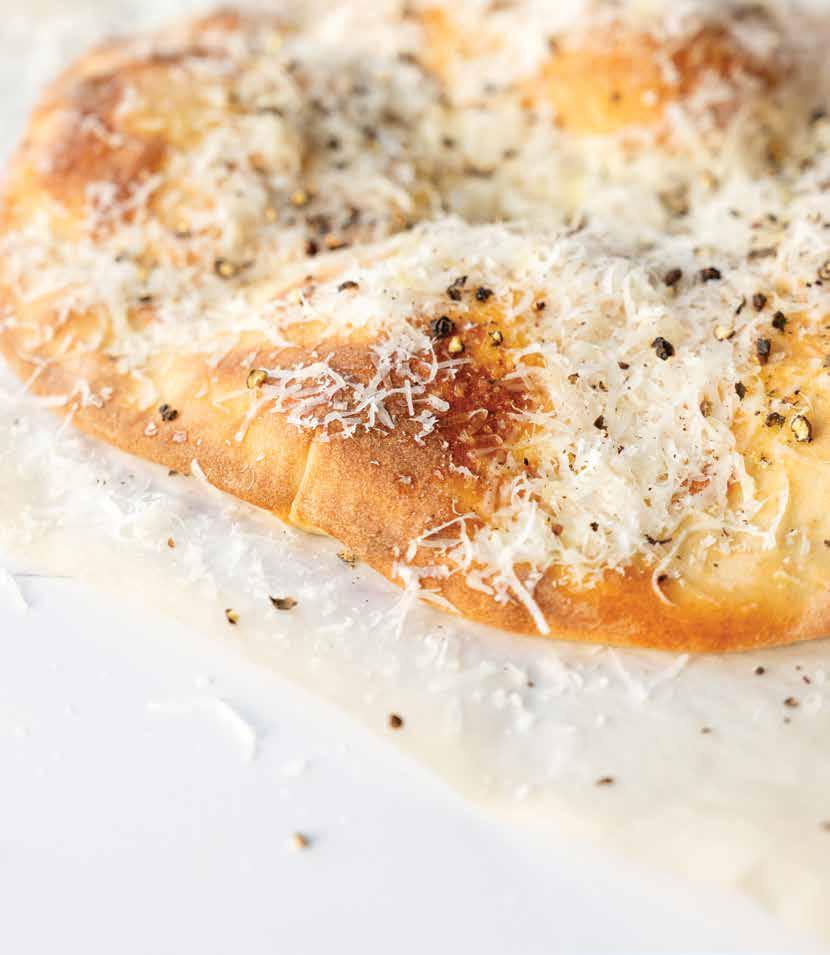
The key to this classic dish is how the pasta water emulsifies with the cheese to create a creamy sauce. Add to this the pop of pepper, you will be hard pressed to throw together a more impressive dish so quicky and with so few ingredients.
SERVES 2
200g spaghetti
salt
2–3 tbsp olive oil
2 tsp pepper, freshly ground
20g butter
chopped parsley
1 cup parmesan or pecorino cheese, finely grated
Cook the spaghetti in a large pot of salted boiling water.
While the pasta is cooking, heat the olive oil in a pan along with the pepper. Cook for 1–2 minutes or until the pepper begins to pop. Add the butter.
When the spaghetti is cooked, drain, reserving ¼ cup of the cooking water and add this and the spaghetti to the pepper pan.
Stir in the cheese and serve immediately.
This is the perfect pizza to start a meal.
1 tsp dried active yeast
1 tsp sugar
2 tbsp warm milk
²⁄³ cup warm water
2 cups flour
1 tsp salt
1 tbsp extra virgin olive oil
¾ cup grated parmesan
cracked pepper
Combine the yeast, sugar, milk and water in a large bowl and place in a warm spot for 10 minutes to activate the yeast. It’s ready when the yeast has formed a foam.
Add the flour, salt and oil and knead for five minutes (by hand or using the dough hook on a stand mixer). When the dough is smooth, place in a lightly greased bowl, cover and allow to stand for 1 hour.
Heat a pizza stone in a 240°C oven.
Divide the risen dough into three and on sheets of baking paper shape into thin approx. 25cm diameter circles.
One at a time cook the pizzas for about 8 minutes, until golden. Immediately sprinkle ¼ cup of parmesan cheese all over the pizza, and season generously with freshly ground pepper.

I love a good old fashioned sausage roll. The pepper in these ones probably means the kids will stay away but that’s not necessarily a bad thing.
3 tbsp olive oil
1 medium onion, finely diced
1½ tbsp freshly ground pepper
1 garlic clove, crushed
500g pork mince
¾ cup parmesan, finely grated plus a little extra for sprinkling on top ½ cup breadcrumbs (fresh or panko)
1 tsp salt
2 eggs, lightly beaten
ready rolled flaky pastry (I used Paneton 500g block available at Vetro and La Cave)
Heat the oil in a small pan over medium heat. Add onion and sauté for 2–3 minutes. Add the pepper and garlic and continue to cook until the onion is soft and translucent. Take off the heat and allow to cool.
Add the cooled onion mixture with the pork, parmesan, breadcrumbs, salt and three-quarters of the beaten egg. Mix well.
Cut the pastry in half. Divide the pork filling in half and create an even sausage of filling down the length of each pastry sheet. Brush edge of pastry with remaining beaten egg and roll to enclose and seal.
Make 12–13 cuts two thirds of the way through the sausage roll then arrange in a circle on a baking tray lined with baking paper. Brush with remaining egg and sprinkle with extra Parmesan.
Bake in a 220°C preheated oven for 20–30 minutes or until golden brown.




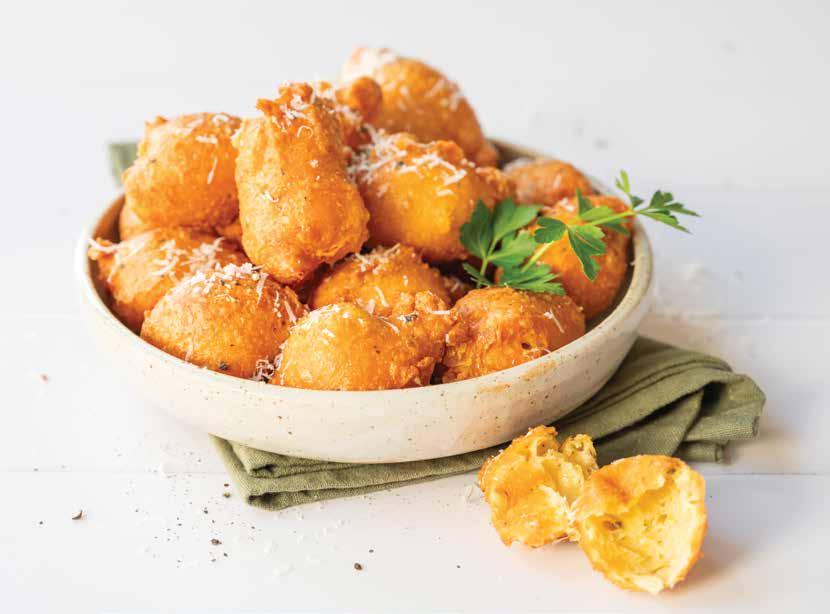
These savoury choux puffs can be deep fried or baked to create a beautiful cheesy pepper puff that make a wonderful canapé.
1 cup water
100 g butter
1 cup flour
1 tsp salt
1 tsp black pepper, ground
1 cup tasty cheddar, grated
1 cup parmesan cheese, grated
3 size 7 eggs, lightly beaten
Place the water and butter in a pot. Bring to the boil and when the butter is melted, add the flour, salt and pepper. Stir vigorously to ensure all the flour is incorporated and the dough starts to form a ball.
Remove from the heat and stir in the cheeses. Use either a stand or electric mixer and slowly add the eggs in, beating well after each addition.
At this stage you can chill the mixture in the fridge until you are ready to cook and serve.
To cook the puffs, deep fry teaspoonfuls at 180°C for 6–8 minutes until golden brown. Drain on a paper towel and serve while still warm.
Alternatively place teaspoonfuls on a lined baking tray and bake in a preheated 200°C oven for 20–35 minutes until golden brown. Serve while warm or allow to cool and fill with rocket and pear salad or thinly sliced roast beef.


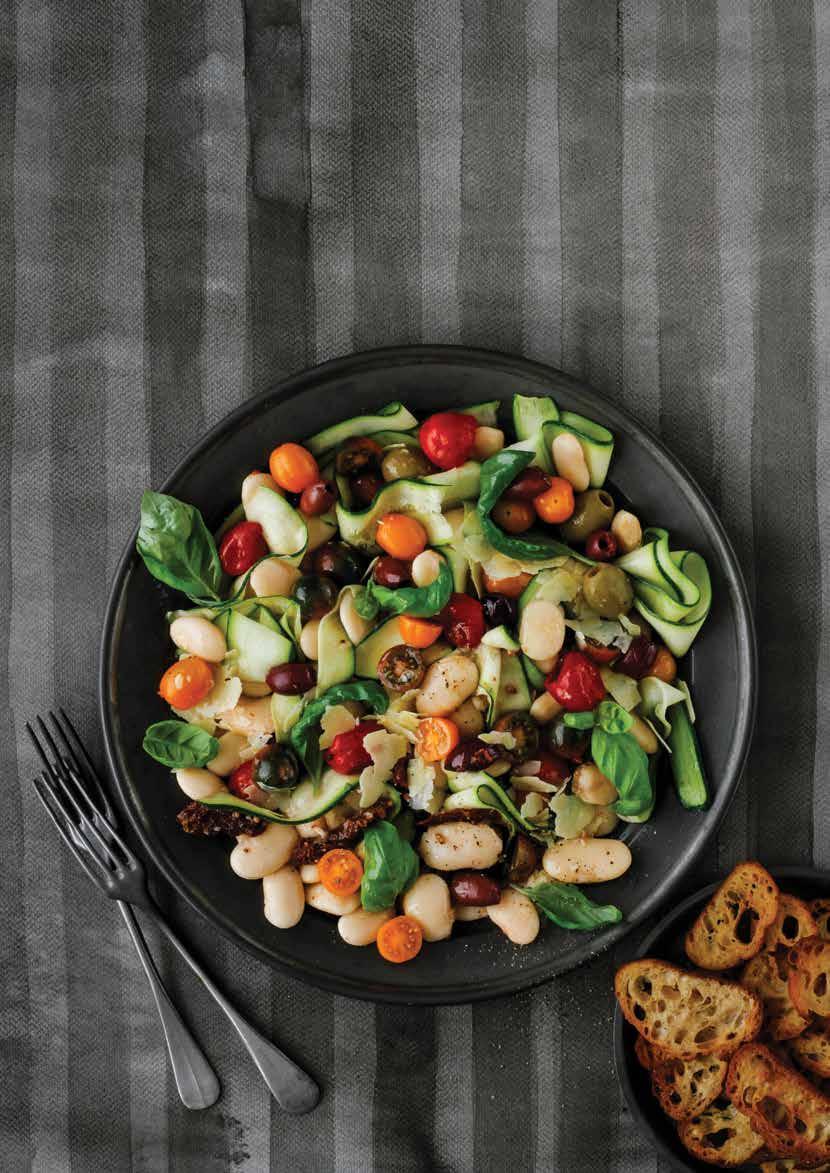

Salads were apparently first consumed thousands of years ago by ancient Babylonians who were known to chow down on various greens and a roughly knocked together combination of salt, oil and vinegar.
The Egyptians, Greeks and Romans also got involved, delving into, I imagine, primitive bowls of course leaves and foraged fruits with, alas, not a creamy dressing or fancy emulsion to be found. As time progressed salads became more complicated, and recipes that were popular with Renaissance folk evolved in to some of the dishes we know today. Tall wigs, bad makeup, inter-spousal copulation and beheadings aside, I’ve taken inspiration from some of those salad concoctions of old to bring you a line-up of dishes fit for royalty … or maybe just to placate the annoying peasants you possibly live with.
COOK’S NOTE – These recipes are all relatively simple, lack usual precision and have been designed for readers to address the recipes ‘au pif’, which is a French phrase for ‘by the nose’. This translated from my Parisian wedlocked opinion is “pour a wine, have a damn good crack at making it, taste as you go, add some, a lot, or not, and just wing it. Oh, and always make sure you have good bread to mop up the lovely oily juices.”
God speed and bon appétit.
Just the word antipasti for me instantly conjures up a bucolic scene of copious glasses of wine on a lazy afternoon with friends, and platters of bountiful tasty wee things to slowly devour. This salad is that very notion but in a bowl, packed full of all the things, and the bonus is you can shovel it in with a fork or spoon. I’ve photographed it here (image previous page) with crostini and without the chalices of booze, but who am I to stop you?
If it’s an occasion or you need to impress, dish out on decent large Spanish butter beans. They’re worth it I assure you and do make the world of difference. Buon appetito!
1 large garlic clove, crushed red wine vinegar
flaked salt & freshly ground black pepper
1 tbsp Dijon mustard
¹/³ cup extra virgin olive oil, plus extra 400g tin cannellini beans, drained ½ cup sundried tomatoes, torn ½ cup preserved artichokes, roughly chopped ½ cup roasted red peppers (I used the mildly spicy small bell ones for added heat)
handful of cherry tomatoes
1 cup Kalamata and green olives, pitted 1 courgette, shaved into ribbons
handful of fresh basil leaves
a shower of shaved pecorino or parmesan small dollop of honey
In the bottom of a large bowl whisk together the garlic, vinegar and salt and pepper with a decent slosh of olive oil. Add the beans and toss to coat. Leave to marinate while you prepare the other ingredients.
Shave the courgette into ribbons and add to the beans and mix to marinate.
Add all the other ingredients, tearing or roughly chopping them into bite-sized pieces.
Mix with the marinated beans, taste, and season well. Place on a pretty platter and serve with crostini or crusty bread.
Just the word gribiche (pron: gree-beesh) conjures up fancy plates, plucked, peeled and poached green whatnots carefully laid out to be admired by wowed guests. It’s a swanky old French recipe for a saucy combination of basically cold egg and mustard but with posh add-ins like shallots, cornichons and capers. No offence, but it’s a damn sight more bourgeois than the chopped eggy mustard powder mash-ups we Kiwis know and love. I’ve served it here over broccolini because I refuse to spend my hard-earned cash on ridiculously priced out of season carbonloaded American asparagus, but when those little local green daggers of springtime delight finally crop up, get it all over them tout suite! Grebiche is also a damn good time with boiled new season baby spuds too, just saying.
handful of broccolini, or a dozen fat asparagus spears
3 large eggs, soft boiled
1–2 tbsp Champagne vinegar or good white wine vinegar
1 tsp Dijon mustard
1 tbsp capers, roughly chopped
5–6 cornichons, roughly chopped, or a tbsp or two of chopped gherkin
1 small shallot, finely sliced
a slosh of extra virgin olive oil
1 tsp of grated zest and lemon juice to taste
4 tbsp finely chopped herbs (I used parsley and chervil here, and sometimes use chives)
flaky sea salt & freshly ground black pepper
Peel the eggs, break them open and place the cooked yolks in a small bowl. Roughly chop the cooked whites and place into another bowl.
To the yolks add the mustard, vinegar and salt and pepper. Stir to combine into a mayo-like consistency. Taste all the time and adjust to suit.
To the chopped egg whites add the shallots, cornichons, capers, olive oil, lemon zest and juice and the chopped herbs. Season to taste. Now at this point you can loosely spoon the yolky mix into the white and mix it together, but I like the look of them separated – it’s more photographic. But to combine or not is totally your call, so knock yourself out.
Simmer broccolini or asparagus in a little salted water until just tender. I use tongs to lift them out, gently shake off excess water and transfer to a serving platter.
Spoon over the gribiche and serve immediately.

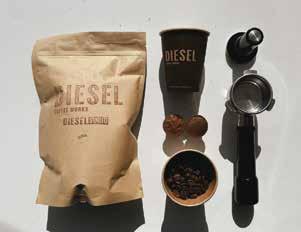


Since the Middle Ages, humans have been smoking salmon to preserve the fish, enabling them to eat it over the long winters.
Thousands of years later it’s rumoured Victoria Beckham eats salmon every day. It’s also said supermodel Elle MacPherson religiously eats greens every day. So surely, I thought, putting these things together and eating this magic formula daily you’re sure to preserve something and have model looks in no time. Either way, benefits or none, it’s a damn nice salad for brunch and lunch or a light summertime supper. Eating it regularly is probably only a privilege if you’re married to a multimillion dollar earning Manchester geezer, such is the price of smoked salmon at the moment, but each to their own, I’m not judging.
a fair bit of telegraph or Lebanese cucumber, thinly sliced lengthways
1 avocado, flesh scooped out and roughly chopped
½ red onion, finely sliced lemon juice and a cheek to serve olive oil
200g hot smoked salmon
1 tbsp capers
a good dollop of crème fraîche fresh chives, chopped
In a bowl combine the cucumber, onion and avocado. Add a little olive oil, squeeze over lemon juice and season.
Lay on a serving platter and top with broken pieces of hot salmon. Blob over a few spoons of crème fraîche and shower the lot in capers. Add a handful of chopped chives and you’re good to go.
For those who know me or follow me, and even all you sleuths and weirdos who like to stalk me, it’s no surprise that dairy is my desideratum, and I also believe that literally nothing is good without a squeeze of lemon. So with these two ingredients combined, I bring you a high performer in the stakes to be my death row meal. Lemons are now at their best and sliced thinly are a fabulous addition to salads. But don’t panic, Sweetie, I can hear you gasping with horror at the face puckering thought of chewing on raw peel, so I’ve poached them here into a sweet and sour sticky syrup that is, frankly, simply frigging magical. Also I can haughtily say, it’s great served over panfried fish or chicken. I’m sure, actually I’m adamant, that you’ll thank me later.
½ cup caster sugar
½ cup Champagne vinegar or good white wine vinegar
small bulb of fennel, including some stem, shaved (reserve some of the fluffy green tops)
2 small lemons, finely sliced stracciatella, buratta or fresh mozzarella with a slosh of cream
cold pressed extra virgin olive oil (as expensive as you can afford)
handful of pangrattato slivered almonds, toasted (optional) flaky sea salt & freshly ground black pepper
In a shallow pan mix together the sugar and vinegar and add the fennel and lemon slices in a single layer. Simmer slowly over a lowish heat for around 20 minutes until reduced, softened and sticky.

Tear the cheese and layer cooked fennel and lemon over the top. Sprinkle over pangrattato and almonds if using and shower over some torn fennel sprigs. Slosh with extra virgin olive oil and season. Ensure you have fresh bread to mop up the sweet, sticky, grassy juices.
stale Italian style bread, baguette or ciabatta, finely sliced
2–3 garlic cloves, crushed 150g butter, melted slop of olive oil
a couple of teaspoons of finely chopped parsley if you feel like it
To make the pangrattato, pre-heat oven to 180°C fan bake.
Mix the garlic into the melted butter and slosh in a little oil with the parsley if using.
Bread is easier to cut when its stale, and this is a great way to utilise leftover ends. Lay the slices of bread on a lined baking tray and brush garlic butter all over slices and sprinkle over a little salt.
Bake until golden. When cool, crush or pulse in a food processor to a rough crumb. Keep in an airtight container and use to sprinkle on pasta and salads.

Fiona Hugues
Born in Hamilton, multi-international award winning food stylist & creative multi-hyphenate Fiona Hugues spent her childhood gallivanting around the Waikato countryside on horseback. After Hillcrest High School, Elam School of fine Arts took her to Auckland where she now resides on a rural property with her French husband, teenage children & a plethora of animals. From photographing food, art directing commercial campaigns to designing restaurants, her creative skills have encompassed a multitude of genres. Named one of Aotearoa New Zealand’s TOP 50 Women in Food and Drink to watch in 2024 she brings the beauty of food, the joy of eating and art of making things look good to her many clients, and these pages.


NZ’S LARGEST RANGE
Of party & cake decorating supplies!
FIND US
on the corner of Rostrevor & Harwood Streets, Hamilton.

Unpopular opinion, but I don’t like avocado. The texture, bland flavour, inconsistency of quality –why is there so much hype surrounding them? I’m the outlier on that opinion though, as millions of people couldn’t live without them.
The idea of a ‘Harriet’s How To – Guacamole’ stemmed from a heated discussion between Vicki, Denise Irvine, Fiona Hugues, and our lovely waiter at Bossi in Auckland. Turns out you avocado lovers are incredibly passionate about guacamole, but it seems like there’s no ‘perfect’ guac as everyone has their personal preferences. Since I’m clearly not the right person to decide on the best guac, I called upon a tasting panel made up of food writer, Denise Irvine; guac connoisseur, Anna Sinclair; the boss, Vicki Ravlich Horan; and veggie guru, Gus Tissink. I asked them to share their essential traits they look for in guacamole. Denise loves a good amount of lime and coriander and it has to use really good avos. Anna loves a chunky texture and tangy notes and it has to have tomato and onion. Vic is a capsicum and garlic lover, which stems from fond guac memories from her time spent overseas. And Gus, like Denise, loves a good hit of lime as well as onion, garlic, and a chunky texture.
Rick Bayless is an American chef who specialises in Mexican cuisine. His recipe uses 3 avos, 1 garlic clove, 1 tsp of salt, 1 tbsp
of lime juice, ¼ cup of coriander, ½ a serrano or jalapeño pepper, ½ a plum tomato, and ¼ of a white onion. The avos are mashed with a potato masher, then seasoned with salt. The garlic, lime, coriander, chilli, and tomato are then mixed through. The onion is minced, then rinsed under cold water before being added into the guacamole.
The overwhelming response after the first taste of this one was that it was salty and lacking in citrus. I made a point of following the salt and lime measurements as accurately in each recipe as possible, although these are the two ingredients where you need to use your tastebuds as a guide. Rick’s guac was at a bit of a disadvantage as the avos I used were the only ones that were on the slightly overripe side, and its well known that you can’t hide a bad avo. Denise was put off by its “burst boil” look, and just hearing that is enough to make me gag. The tomato flavour was lost, as was the small amount of rinsed onion and the avo itself. All round, it was a bit bland and was rated fourth by Denise and Gus, and third for Vicki and Anna. Had I made this with perfectly ripe avos, I think it would have been higher ranking.
Carolynn Carreno is a food writer based in Los Angeles whose guacamole is world famous amongst her friends. It’s a fiveingredient recipe consisting of 4 serrano chillies, rock salt, ⅛ of a white onion, 4 avocados, and 1–2 key limes. Carolynn uses an authentic molcajete, which we would call a mortar and pestle, to turn the small amount of onion, rock salt, and the chillies into a ‘slimy paste’. The avocados and lime juice are then pounded until
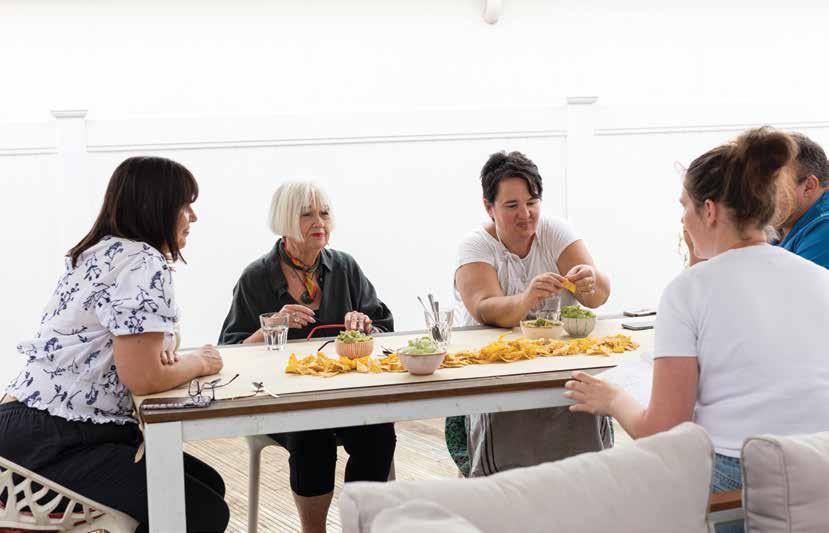
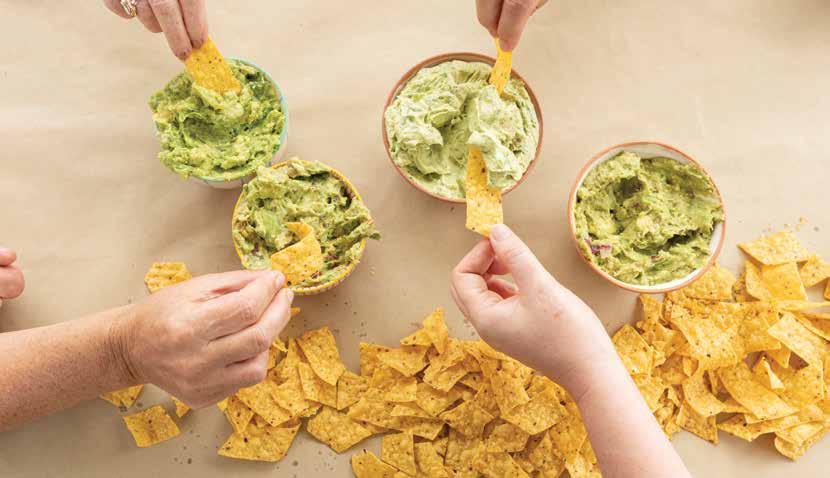
combined with the paste, along with more salt. She says, “Taste it again, adjust the seasoning, and just when you think it’s perfect, add some more salt and serve.”
I don’t feel like it’s fair on Carolynn for me to have used this recipe in the line-up. The average New Zealander can’t easily get their hands on serrano chillies, white onions, or key limes, so I substituted these ingredients for pickled jalapeños, red onion, and pouch lime juice because at the time, I didn’t have access to fresh limes.
Everyone instantly commented that this recipe was saltier than Rick’s, so it seems like I took Carolynn’s salt advice too far. It had a good heat to it, but it distracted from the avocado and, once again, was lacking in citrus. Vicki said this one had a “banana” aftertaste, and Anna thought it was “one dimensional”, so this was clearly not their favourite and it was their fourth pick. Gus and Denise ranked this second, but they still wouldn’t make this one at home. I’d love to try this guac with the authentic ingredients because with a dish so simple, ingredient quality is key.
MARTHA STEWART
I wanted to try a guac that had sour cream in it, so I picked Martha Stewart’s Creamy Avocado Dip. This recipe combines 2 avos, 1 cup of sour cream, ½ cup coriander, 1 tbsp lime juice, 1 jalapeño, and ½ tsp coarse salt in a food processor and it’s blitzed until smooth. Initially, Denise was loving the creaminess of this until the fatty, coat-your-mouth feel took over. It tasted a bit like a processed dip you would buy from the supermarket, and no one was a fan of the smooth texture. It has a good jalapeño kick to it but once again, the 1 tbsp of lime juice wasn’t enough. This dip would be perfect on nachos, wraps, or to serve to kids, but it doesn’t cut it as a guacamole to serve with chips. Denise and Gus had this ranked third and it came in second for Vicki and Anna.
NIGELLA LAWSON
Initially, I had a completely different recipe in mind for my fourth option, but Denise insisted that this is the one and only guacamole
recipe she makes and it should be tested amongst the panel. Nigella’s recipe uses 3 “properly ripe” avocados, the juice of 3–4 limes, 4 tbsp of coriander, scant teaspoon of salt, 4 finely sliced spring onions, and ½–1 fresh green chilli, finely chopped. The salt is dissolved in the lime juice, then the avocado is mashed with a fork before having all ingredients stirred into it.
This guac had a stunning vibrant green colour and it stayed that way the whole time it sat on the table. Martha’s guacamole was a pale green because of the sour cream, but Carolynn and Rick’s progressively browned as they sat out. This was the unanimous favourite. The highlights were the chunky texture and good amount of salt. The spring onion added an element of freshness and texture without it being as intense as chunks of raw red or brown onion. I used 1 tbsp of lime juice per “juice of a lime”, and for the fourth time in a row, it needed more lime. The chilli and coriander weren’t prominent in the flavour but everyone agreed that more spice would ruin it.
I tasted every recipe and was almost convinced that avocado could be a part of my diet, but I haven’t eaten one since that day. After trying the series of guacs, it’s evident that lime juice is the key ingredient in a good guac. The final recipe is based off Nigella’s, while trying to cater to the tasting panels’ preferences and availability of ingredients. The use of the mortar and pestle created the best textured guac and it’s the traditional equipment to use, so I have incorporated that into my recipe as well.

Harriet Boucher
Harriet is a Waikato born and raised foodie. She is a chef by trade and has worked in a few popular cafes and restaurants around Hamilton. When she isn’t whipping up treats, you can find her enjoying a walk along the river or dining at her favourite local eateries.
RECIPE HARRIET BOUCHER | IMAGE BRYDIE
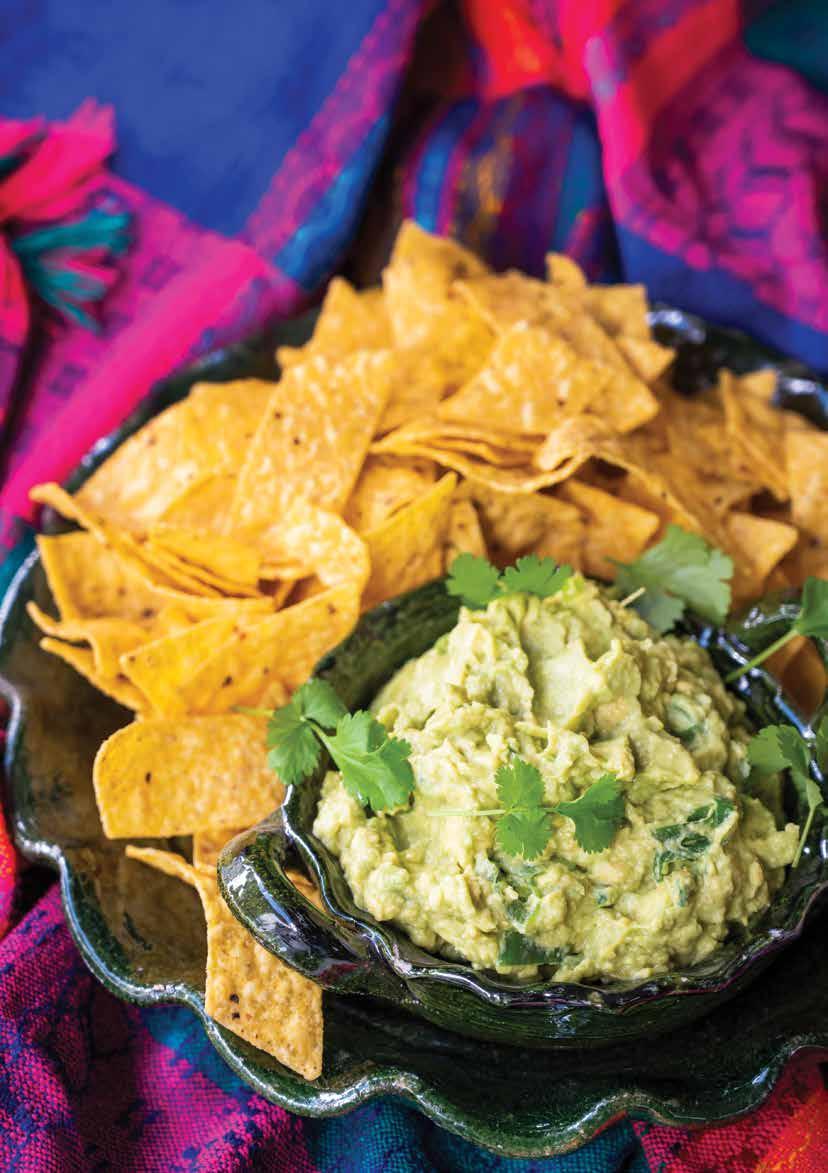
GUACAMOLE
Whether you’re dipping corn chips, filling tacos, or topping nachos, this guac won’t fail you. If you don’t have a mortar and pestle, you can use a fork to smash the avos, finely crush the garlic and jalapeños, then stir it all together.
1 plump clove of garlic
4 slices of jalapeños (we used the pre-sliced ones from a jar)
2 perfectly ripe avocados (use 3 if they’re small)
1 large spring onion, finely sliced
small handful of coriander, finely chopped
3–4 tbsp fresh lime juice
In a mortar and pestle, grind the garlic and jalapeños together to form a paste. Once smooth, add in the avocados and smash until combined with the paste, leaving the texture slightly chunky.
Stir in the spring onion, coriander, and 3 tbsp of lime juice, then taste. Add in the remaining lime juice and a pinch of salt if needed. Don’t be afraid to add salt, but be aware that the jalapeño brine adds saltiness, so don’t add it until you’ve tasted it.
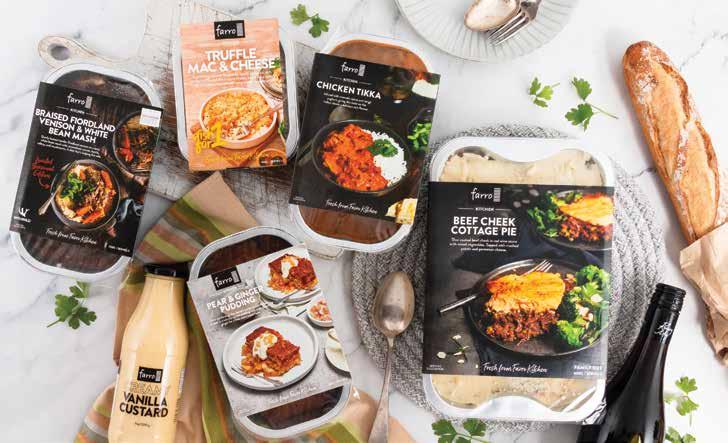
Create good times with Farro this spring
Farro available at 41 Duke Street Cambridge


With over 60 years of experience, Treetown Designer Kitchens is a trusted expert in creating custom kitchen and interior joinery solutions for homes and commercial spaces in Cambridge, Hamilton, and the greater Waikato region. W: www.treetownkitchens.co.nz P: 07 827 7309 E: info@treetownkitchens.co.nz Image thanks to LIV.visuals

In his kitchen in Gordonton, Wayne Good regularly wows guests with inspirational cooking workshops, be it tried and true recipes from his vast repertoire or ones inspired by his recent travels. The classes are fun and informative, and all conclude with the opportunity to enjoy what Wayne has whipped up.
Wayne's Christmas classes are legendary, always selling out as guests return each year to be inspired for the festive season ahead! So, get in quick!
WAYNE’S
When November 16, 17, 19, 20, 22, 23, 24, 26, 27, 29, 30, December 1, 3, 4, 6, 7, 8.
Where Arkanda, 128A Whitikahu Road, Gordonton
Cost $95.00pp
Book email wayne@arkanda.co.nz

SOURDOUGH BREAD WORKSHOP
Learn how to make your own sourdough bread at home. Brad will cover the basics of bread making and demystify the process of using a natural leaven. He will share 3 simple bread recipes and provide everyone with a sourdough starter to take home and recreate the magic.
When Sunday 3 November
Where The Falls Retreat, 25 Waitawheta Road, Waikino, Waihi
Cost $150pp, includes morning tea and nibbles on arrival, workshop with take home instruction book/notes and a delicious shared lunch.
THE FULL MONTY EDIBLE GARDENING WORKSHOP
This one-day course with The Falls Retreat resident gardener Nicki Murray-Orr will teach you a comprehensive range of skills and techniques to get the most out of your veggie garden.
When Sunday 6 October or Sunday 3 November
Where The Falls Retreat, 25 Waitawheta Road, Waikino, Waihi
Cost $150pp, includes morning tea and nibbles on arrival, workshop with take home instruction book/notes and a delicious shared lunch.
SALADS AND DRESSINGS WORKSHOP
Taking you from the garden to the dinner table no matter what the season. Enjoy a full day workshop including an interactive session in The Falls Retreat kitchen veggie gardens and a cooking demo, where you will watch and learn how to create a range of salads and dressings with the wow factor using seasonal produce.
When Sunday 6 October
Where The Falls Retreat, 25 Waitawheta Road, Waikino, Waihi
Cost $150pp, includes morning tea and nibbles on arrival, workshop with take home instruction book/notes and a delicious shared lunch.
Book any of these workshops at www.fallsretreat.co.nz

DECOUPAGE
When Thursday 12 & 19 September, 7.00pm
Cost $125pp
ONE DAY DECOUPAGE WORKSHOP
When Saturday 12 October or 9 November, 10.00am to 3.00pm
Cost $150 including lunch
MAKING MOULDS
When Thursday 3 October, 7.00pm
Cost $100pp
FRENCH LAYERED CARDS WORKSHOP
Create three personal cards that can then be used as art pieces using old French holy cards, photos, lace, stamps, fabric, paper etc.
When Thursday 14 November, 7.00pm or 21 November , 7.00pm
Cost $75
Where 40 Duke Street, Cambridge
Book any of these workshops at www.heritagetrading.co.nz

Jennifer Duval Smith will guide you through this fun and explorative practice using nature journaling principles to observe and capture a plant subject. No experience necessary, just bring your enthusiasm and willingness to learn! Includes morning tea.
When Sunday 22 September
Where 25 The Falls Retreat, Waitawheta Road, Waikino, Waihi
Cost $155pp, includes morning tea, art session with all materials and a delicious lunch.
Book www.fallsretreat.co.nz

Learn the basics of cake decorating with Lynn Broderick from This Little Cakery.
When 5-week course, starts 16 October
Where Sweet Pea Parties, 70 Rostrevor Street, Hamilton
Cost $249pp
Book www.sweetpeaparties.co.nz

Join us for a creative night of painting – no experience necessary! Also available for private bookings, perfect for hens dos and Christmas parties.
When Afternoon and evening sessions
Where Local bars and restaurants across New Zealand
Book paintvine.co.nz

The Floral Shed is a beautiful, rustic garden destination transformed from a 130-year-old wool shed into a botanical dream, offering year-round floral workshops and diverse botanical experiences.
Where The Floral Shed, 246 Reid Road, Ngāhinapōuri
When Hosted once or twice a month on Saturday mornings all year round.
Book www.thefloralshed.com
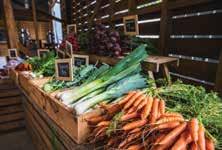
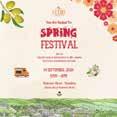

WAIKATO FARMER'S MARKETS
Where local and convenience collide, the Waikato Farmer’s Markets are on every weekend come rain, hail or shine.
Cambridge Farmer’s Market, every Saturday 8am–12noon, Victoria Square
Hamilton Farmer’s Market, every Sunday 8am–12noon, The Barn, Claudelands www.waikatofarmersmarkets.co.nz
VETRO SPRING FESTIVAL
Market stalls, Italian cars, music, pizza, paella, pasta and so much more. Come for lunch, early dinner, or stay for the whole day!
14 September – 9am – 4pm Rostrevor Street (Vialou end of Rostrevor Street) www.lovethecentre.co.nz
PROGRESSIVE DINNER
Back for another year this unforgettable dining experience in the heart of Hamilton promises guests great food, wine, entertainment and let’s not forget some surprises, including where you will be going.
Thursday 3 October 5.30pm
Hamilton Central location $185pp + booking fees events.humanitix.com/cbd-progressivedinner-2024



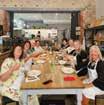
PINK WALK & RUN 2024
Bringing together individuals and groups to help raise awareness and funds for breast cancer research. You can have fun on the 3.8km walk around Hamilton Lake or take on the challenge and run 5km.
Thursday, 31 October, 4.30pm Innes Common, Hamilton Lake www.pinkwalk.co.nz
YAMAHA ROLLOS MARINE BRIDGE 2 BRIDGE
The 40th edition of New Zealand’s favourite water ski race is once again sponsored by long term supporters Yamaha Marine New Zealand and Rollos Marine. 8–10 November www.skirace.co.nz/bridge-to-bridge
BOP GARDEN ARTS FESTIVAL
Get ready to explore the wonderful Bay of Plenty and visit your choice of over 60 beautiful gardens and meet more than 100 magnificent artists. 14–17 November www.gardenandartfestival.co.nz
TASTE OF SOUTH AUSTRALIA TOUR
Join Vicki from Nourish for five fabulous days discovering the taste of South Australia. This small group tour is packed with market, winery and brewery tours, cooking classes as well as fabulous meals.
20–25 November | Cost $4500pp (twin share, including flights) www.nourishmagazine.co.nz click on food tours






STORIES IN THE GARDEN
Come on a magical adventure under the trees in Garden Place. Enjoy an hour of storytelling and games with characters from Enchanted Entertainment.
9 & 23 November – 10am–11am Garden Place www.lovethecentre.co.nz
TIS THE SEASON WITH ALLYSON GOFTON
The Cake Detective presents a festive evening of Christmas deliciousness and holiday gift ideas with the beloved chef and baker Allyson Gofton. By purchasing a ticket, you’re not just treating yourself to an evening of joy—you’re also giving the gift of a birthday cake to a child facing hardship.
Thursday 14th November, 7pm Te Ao Marama School, Flagstaff $55pp www.thecakedetective.org.nz
LUGTON’S ROUND THE BRIDGES
Take part in Hamilton's most iconic fun run! You can take on the 12km, 6km or kids 1km or 2km challenge.
17 November – 7.30am–1pm Garden Place www.roundthebridges.co.nz
SUSTAINABLE CHRISTMAS LUNCHEON
The Falls Retreat are hosting a very special Christmas luncheon focusing on consuming more mindfully over the Christmas season. Bestselling author of Living Lightly, Nicola Turner will share inspiring stories, practical tips and time saving hacks to simplify your life and help you make more sustainable choices meaning less stuff, less waste and less impact!
Sunday 24 November, $149 per person www.fallsretreat.co.nz
HAMILTON CHRISTMAS TREE LIGHTING FESTIVAL
An unforgettable night as the Christmas tree is lit up for the first time! Food trucks, characters, face painting, balloon art and live entertainment.
The Christmas tree will light up the nights from the end of November right through to the new year.
30 November – 5pm–9pm Garden Place www.hamiltonchristmas.co.nz
FIRST CREDIT UNION CHRISTMAS PARADE
Pre-parade 1.15pm–2pm, includes colourful characters and Corporate Clowns handing out lollies.
8 December, 2pm Anglesea Street www.hamiltonchristmas.co.nz




